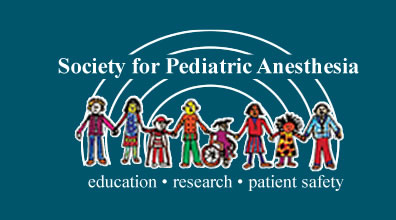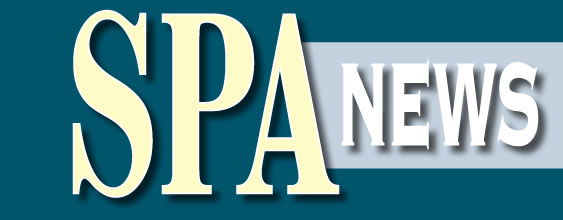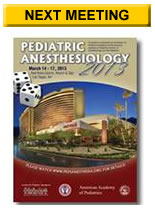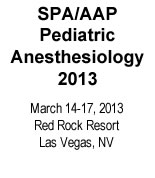Congratulations to the New SPA Officers and Directors
Officers
 |
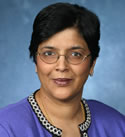 |
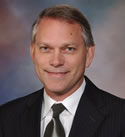 |
 |
Directors
 |
 |
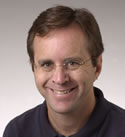 |
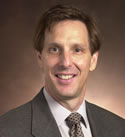 |
| Rita Agarwal, MD, FAAP | Randall M Clark, MD, FAAP | Joseph Cravero, MD, FAAP | Charles Dean Kurth, MD, FAAP |
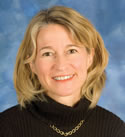 |
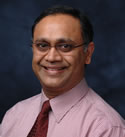 |
||
| Mary Ellen McCann, MD, MPH | Santhanam Suresh, MD, FAAP |
Greetings to All SPA Members!
2012 has been a great year for the Society, and 2013 promises plenty of excitement and activity as well.
It is an honor for me to serve as your President for the next two years. The Society continues to grow and mature, supporting the full range of clinical, educational, and research interests of our members, while working to improve safety and quality for children in the perioperative environment. Your officers and Board members are fully committed to the thoughtful and strategic use of your membership dollars as we expand our educational and advocacy efforts.
My goal for the next two years is to build on the leadership of my predecessors, strengthening Board processes and transparency, updating our by-laws and strategic plan, and engaging more effectively with both our young graduates and our private practice colleagues—making sure that we are addressing the professional and developmental needs of both of these key groups. In addition to our internal constituents, we will work to strengthen our relationships with other organizations, collaborating and cooperating on projects of mutual interest and benefit.
Our recent International Assembly of Pediatric Anesthesia was a success. Over 700 registrants attended the meeting in Washington DC, which was a wonderful blend of information-sharing about international anesthesia service and education projects, networking, and just plain fun! The PBLDs, offered for the first time at the annual meeting, were so popular that we have decided to repeat them in 2013.
Coming up next is the Winter 2013 meeting, to be held March 14-17 at the Red Rock Resort just outside Las Vegas. As is typical for our winter meeting, the program this year is again packed with lectures, abstracts, PBLDs, and workshops; both the CCAS and the Pediatric Pain Medicine Special Interest Group are hosting full-day meetings on Thursday, prior to the beginning of the SPA-AAP joint meeting. Sign up now on the SPA website at www.pedsanesthesia.org!
We are initiating an additional educational project this year, offering (twice) a time-efficient, intense review of the breadth and depth of current pediatric anesthesia knowledge. These two identical courses, held at airport hotels in Dallas (May) and Chicago (August), will begin on Friday evening and end mid-day on Sunday, ideally suited for the busy schedules of practitioners. A great opportunity to solidify your knowledge and wipe the cobwebs out of your brain—check the SPA website for details and registration!
Our annual meeting on October 11, 2013 will return to our normal one-day format, held just prior to the ASA Annual Meeting in San Francisco. Our focus for that program will be on Perioperative Care of the Neonate.
And finally, the first-ever Board Certification Exam in Pediatric Anesthesia will be offered by the American Board of Anesthesiology on Saturday, October 19, 2013. Please go to the ABA website for eligibility criteria, application process, dates, deadlines, and fees. As updated information about the exam and testing sites is released to us, we will post those official ABA communications on the SPA website. http://www.theaba.org/
Working with members and leaders of the SPA has honestly been one of the most satisfying parts of my professional career, and I hope that YOU will find your participation gratifying as well. Please feel free to contact me directly with ideas, suggestions, and gripes: nglass@bcm.edu
This is, after all, YOUR Society FOR Pediatric Anesthesia — please get involved!
Best wishes to you all for a peaceful holiday season with family and friends, and for a HEALTHY year to come.
Advancing Global Health
I’m excited to present this post-International Assembly for Pediatric Anesthesia (IAPA) edition of the newsletter to you. IAPA was an incredible event, indeed a milestone for our society and specialty. The meeting itself can be described with any number of adjectives: inspiring, educational, humbling… what a fabulous opportunity we had to network across national boundaries and better understand the challenges and opportunities we all face in providing safe perioperative care for our patients.
Personally, I think the visiting scholars program was hugely successful. It offered wonderful opportunities for both the scholars and the hosting centers to establish relationships, share knowledge and inspire collaboration. We include one description of a visiting scholar’s experience with many more to follow in the next edition.
Much of the newsletter comprises a comprehensive review of the meeting itself. Additionally, we celebrate a longstanding SPA member, Mark Newton and his lifetime of work in East Africa. Also, we applaud the appointment of one of our own, Dr. David Nichols, as the next president and CEO of The American Board of Pediatrics. For those inspired to see the good work of IAPA continue, there is a review of SPACIES (SPA Committee for Education and International Service), an excellent avenue via which SPA members can make a difference.
Other ways for pediatric anesthesiologists to impact healthcare outside their operating rooms exist, too. To illustrate, a personal account of a medical trip to India is followed by an article that asks the question: Why should health metrics matter to anesthesiologists?
As always, there is something educational to digest. In this edition, we review and compare new airway devices.
In reading this newsletter, I hope you will be inspired to continue the work that IAPA started. Ultimately, the success of IAPA will be determined by the friendships made in DC, relationships established between people and centers, and a commitment from all of us to work to improve patient safety, both home and abroad.
SPA Seeks Your Support for Patient Safety Initiative
By Shobha Malviya, MD, FAAP
University of Michigan Health System
The Society for Pediatric Anesthesia (SPA) strives to continually advance the safety and the quality of anesthetic care, perioperative management, and alleviation of pain in children. In the spirit of promoting patient safety, the Society kicked off the celebration of its 25th anniversary in October 2011 by initiating a fundraising campaign to support the Patient Safety Education and Research Fund. This campaign has a target of raising an additional $500,000 in pledges and donations. The goal is to create an endowed research fund to support starter grants for novel and innovative studies investigating pediatric anesthesia safety.
All the current officers, board of directors, past presidents and past board members have demonstrated their commitment to the patient safety initiative by making generous pledges over a five year period. To date, the pledges exceed $160,000 and more than a third of these pledge payments have been collected. However, to support this program, the SPA needs your help in achieving its goal of raising $500,000. The SPA officers and board of directors request all members to consider making a pledge of support to the Patient Safety, Education and Research Fund. The Society will match dollar for dollar all donations made during the year 2012.
Our Society approaches the end of another exciting and productive year with highly successful endeavors directed at improving the quality of perioperative care in children. The “Wake Up Safe” program, that reviews and analyzes the adverse events reported by 19 participating institutions, now has 644 events recorded in its registry. Data from this registry have led to national practice recommendations to reduce wrong side regional blocks and reduce the risk of transfusion related hyperkalemic arrest. Additional data are currently being compiled and reviewed.
The Pediatric Regional Anesthesia Network (PRAN) seeks to learn more about risks, complications and practice patterns in regional anesthetics in infants and children. There are now more than 46,000 blocks in the database reported by 17 participating centers. Importantly, several abstracts and peer reviewed publications have arisen from data reported to PRAN that will undoubtedly reform the safe practice of regional anesthesia in children. In addition to these programs, the recent International Assembly for Pediatric Anesthesia, our 26th annual meeting with the theme of Safety Knows No Borders opened with keynote speaker Dr. Peter Pronovost, a world renowned expert in the science of patient safety. The program also included several international faculty who came together to educate us about global patient safety endeavors.
As 2012 draws to a close, please consider partnering with your society to expand the impact of this groundbreaking work by making a year-end gift. Now more than ever, your support is vital to fund important research directed at improving the safety of the children under our care. Members interested in supporting this initiative by making a tax deductible donation or a pledge may do so by logging in to the members’ section of the SPA website (www.pedsanesthesia.org) and clicking on the “Donate to the Patient Safety Education and Research Fund” link under the “About SPA” tab. Association manager Kim Battle may be contacted at kim@societyhq.com if additional assistance is needed.
The SPA thanks its members for their ongoing support.
Dr. Nichols Selected as President and CEO of ABP
By Myron Yaster, MD
Richard J. Traystman Professor
Departments of Anesthesiology, Critical Care Medicine, Pediatrics, and Neurosurgery
The Johns Hopkins University
One of the original and founding members of the Society for Pediatric Anesthesia, David G. Nichols, MD, MBA, FAAP, and Vice Dean for Education at the Johns Hopkins University School of Medicine, was selected as president and CEO of the American Board of Pediatrics (ABP) effective in December. He succeeds James A. Stockman III, MD, FAAP, who has led the ABP for the past 20 years.
Dr. Nichols received a BA in molecular biophysics and biochemistry from Yale University in 1973 and obtained his MD with honors at Mount Sinai School of Medicine in New York in 1977. After completing residencies and fellowships in pediatrics, anesthesiology, pediatric anesthesia and critical care medicine at the Children’s Hospital of Philadelphia, he joined the Hopkins faculty in 1984. From 1984 to 1987, Dr. Nichols was associate director of the residency education program in the Department of Anesthesiology and Critical Care Medicine. He became director of the Division of Pediatric Critical Care and of the pediatric intensive care unit (PICU) in 1988. The division was merged with pediatric anesthesiology under Dr. Nichols’ leadership in 1997. During this period, he trained and mentored more than 50 postdoctoral fellows, many of whom now are professors or directors of PICUs in the United States and abroad.
Dr. Nichols became a full professor of anesthesiology/critical care medicine and pediatrics in 1998 and a professor of education in 2005. He has written more than 80 professional journal articles and abstracts, held 17 guest professorships, headed more than 20 symposia and delivered more than 115 guest lectures. He also has been editor in chief of the leading textbooks in pediatric critical care medicine and edited Rogers Textbook of Pediatric Intensive Care and Critical Heart Disease in Infants and Children.
Named vice dean for education in 2000, Dr. Nichols oversaw undergraduate, graduate, residency, postdoctoral and continuing medical education programs, as well as the Welch Medical Library. He has led a wide variety of significant initiatives to improve the school of medicine’s innovative use of technology in education; update the medical school’s curriculum; improve faculty development by revising tenure and promotion guidelines; restructure graduate medical education; oversee the design of a new $50 million medical education building; and enhance diversity throughout Johns Hopkins Medicine.
Perhaps his his least well known accomplishment is that he has put up with my craziness for over 30 years and has remained my best friend and brother.
Dr. Mark Newton Extends Humanitarian Mission Across the Globe
By Jill Clendening
Communications & Marketing Coordinator
Vanderbilt Department of Anesthesiology
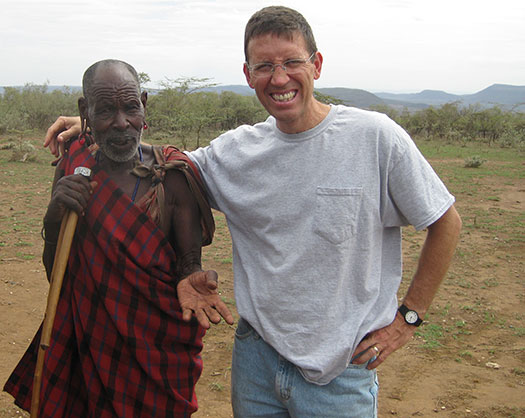
Dr. Mark Newton, a pediatric anesthesiologist at Monroe Carell Jr. Children’s Hospital at Vanderbilt, lives all but ten weeks per year in Kenya, where he is involved in anesthesia development as well as community development projects with the Massai.
When Mark Newton, MD, speaks of the urgent need to reach medically underserved populations throughout the world, his words of compassion are backed up by 15 years’ worth of action. An associate professor in the Department of Anesthesiology at Vanderbilt University School of Medicine and a pediatric anesthesiologist at Monroe Carell Jr. Children’s Hospital at Vanderbilt, he was instrumental in founding, and now directs, the Vanderbilt International Anesthesia (VIA) program.
Established in 2007, VIA is the Vanderbilt Department of Anesthesiology’s global service, education, and research initiative which focuses on anesthesia and ICU issues in low resource countries. Mark spends the majority of his time at Kijabe Hospital in rural Kenya where he is involved in anesthesia development projects in Kenya, Southern Sudan and the Horn of Africa, working alongside African anesthesia care providers and educators. He has spearheaded the development of a non-physician anesthesia training program based at Kijabe Hospital, and thus far, there have been more than 50 graduates, with 100% now providing anesthesia care in rural East Africa. In these areas, they work with very limited resources, often without pulse oximetry or functioning anesthesia machines.
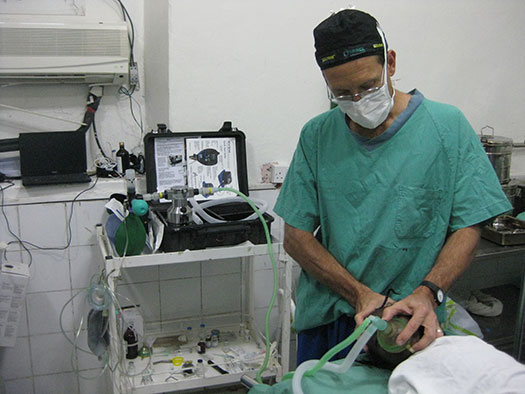
Dr. Newton provides draw-over anesthesia with a halothane induction during a pediatric case. In areas where electricity and an oxygen source are unreliable or unavailable, this method is a mainstay of inhalational anesthesia. Yes, halothane is still used in low-resource countries on a daily basis.
Mark’s humanitarian efforts in healthcare were recently recognized by the American Medical Association with the presentation of the Dr. Nathan Davis International Award in Medicine. Named for AMA’s founder, the award honors physicians whose influence reaches the international patient population and transforms the future of their medical care. Dr. Newton was also honored when the University of Texas Medical Branch at Galveston Alumni Association awarded him the Ashbel Smith Distinguished Alumnus Award during the UTMB School of Medicine’s commencement ceremony in June 2012. The award — the highest honor bestowed by the alumni association — recognizes outstanding service to the medical profession and to humanity and honors the memory of Dr. Ashbel Smith, a prominent figure in Texas medicine, politics and education.
“Over the span of his career, Mark has contributed substantially, and at great personal sacrifice, to international anesthesia education and training in low income countries,” said Warren Sandberg, MD, PhD, Chairman of the Vanderbilt Department of Anesthesiology. “Anesthetic morbidity and mortality are a leading cause of death among surgical patients in developing countries, largely due to lack of trained personnel. Mark embodies, in spirit and action, the true meaning of a physician servant, and his personal contribution to healthcare on an international level will have a perpetual, positive impact.”
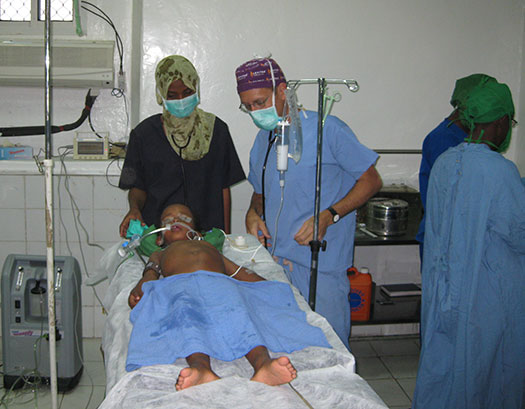
Dr. Newton trains pediatric anesthesia providers in the Horn of Africa region without an anesthesia machine. You can see the oxygen concentrator in the background.
Mark completed his pediatric anesthesia fellowship in 1992 at Denver Children’s Hospital, which became his base while he worked in East Africa from 1997 until 2007, when he became a Vanderbilt faculty member. He feels his role in community development in Kenya is as equally important as his clinical mission. Over the past 15 years, Mark and his wife, Sue, have become a part of a close-knit Massai community on about 50 square miles dotted by Acacia trees and shrub bushes and laced with dry river beds in the middle of the Rift Valley of Kenya. The couple has witnessed the construction of a primary school serving more than 300 children; a project to provide clean drinking water; and the development of an adult women’s education program which has dramatically improved the social status of the region’s women. Developments such as these can only be actualized by a long-term commitment to an area of the world where relationships are created and strengthened by sharing hundreds, or even thousands of cups of chai (tea).
Although the vast majority of his time is spent in Kenya, Mark is also involved in surgical safaris each year to some of the most unstable countries of the world bordering Kenya. In the late 1990s, during the height of Sudanese Civil War, he spent time in a small Southern Sudan hospital where bombs were dropped while he trained anesthesia care providers. He has also spent considerable time in the Horn of Africa where medical schools are being established and medical students taught basic anesthesia skills. Current plans are to expand anesthesia training for physicians and non-physicians to some of these surrounding countries.
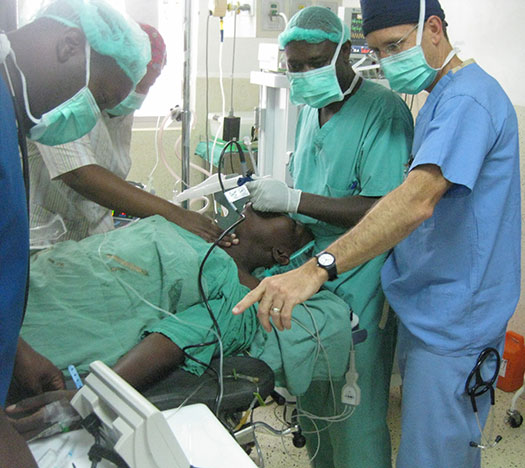
Dr. Newton provides airway training for Kenyan Registered Nurse Anesthetists (KRNA) at Kijabe Hospital (Kenya) with a life-saving GlideScope donated by the company.
Dr. Newton has never considered his time in Africa as sacrifice, since it now has become his home. Certainly his five children, including two adopted Kenyan children, feel much more comfortable in a mud hut surrounded by African children than running around texting and using mall escalators. And, though he’s thankful for the recent accolades received as a result of his humanitarian efforts, Mark is eager to translate that personal affirmation into additional recognition, support and growth for the VIA program and Kijabe Hospital’s programs for training healthcare providers in Africa, and other resource-poor areas of the world.
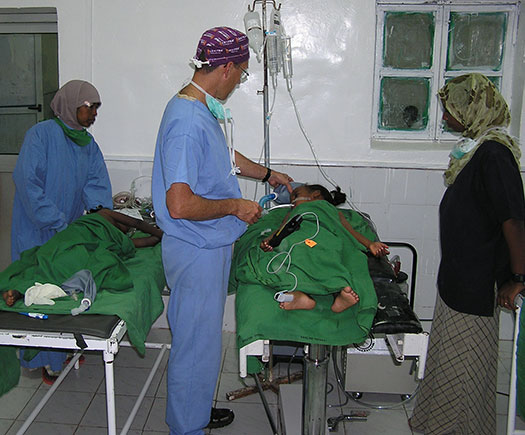
Healthcare providers in rural hospitals in countries surrounding Kenya receive pediatric PACU education. Notice the lack of monitors.
“When I move between the two health care systems, in the United States and Africa, I am saddened by wasted resources, both supplies and manpower, compared to the stunning anesthesia care needs in Africa,” he said. “After 15 years working alongside my African anesthesia care providers and surgical colleagues at Kijabe Hospital, I am convinced that our desire to help should be directed toward anesthesia, surgical and obstetrical medical education. We have a tremendous opportunity now to partner in the development of a pediatric anesthesia fellowship program for East Africa.
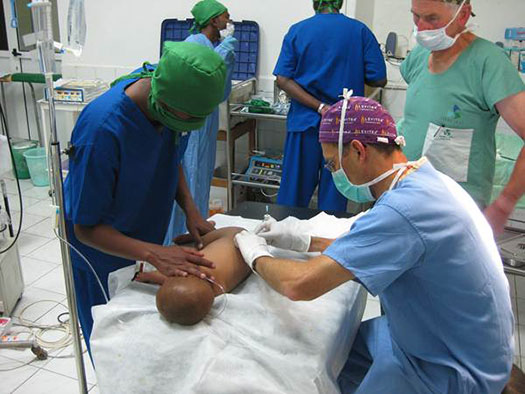
Increasingly, regional anesthesia skills are being taught to providers in Kenya as an alternative to general anesthesia in the pediatric operative setting. This is a hypospadias repair under spinal anesthesia in a rural hospital.
Although obstacles always need to be hurdled, the future could look brighter for the children – in some African countries more than 50% of the population is less than 15 years old – if VIA and many international and East African partners are able to train young African physicians in pediatric anesthesiology. Our anesthesia colleagues who are working in difficult environments need our partnership to build programs which are sustainable for clinical care, education and eventually, research.”
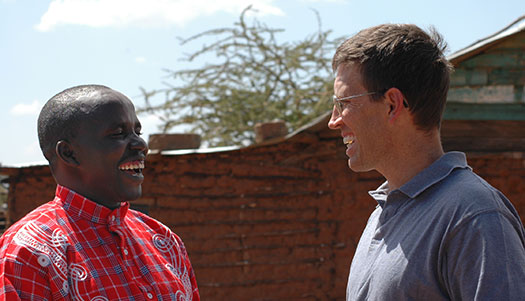
In Kenya, Simon, a Massai leader, and Dr. Newton share a laugh. There, Dr. Newton and his family are considered to be brothers and sisters to the Massai people.
One Kenyan anesthesia care provider trained by Dr. Newton recently told him, “We may forget a drug dose, or a disease, but we will never forget what you and your family have done for our country. You will always be in our hearts because you now are one of us.”
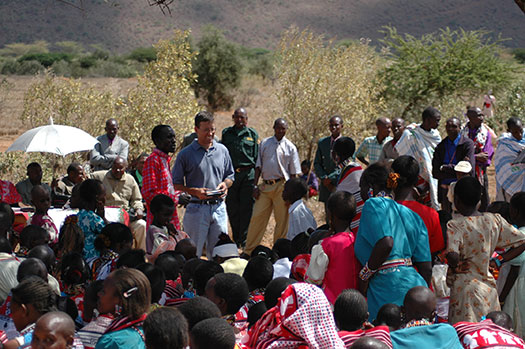
Dr. Newton is involved in community meetings and training sessions amongst the Massai in the Great Rift Valley, less than one hour from the Newton’s home in Kijabe.
SPA IAPA/ASA Meeting Reviews
Keynote: The Science of Safety
Reviewed by:
Christopher Smith, MD
CA-4 Chief Resident Detroit Medical Center/Wayne State University
Zulfiqar Ahmed, MD, FAAP
Anesthesia Associates of Ann Arbor
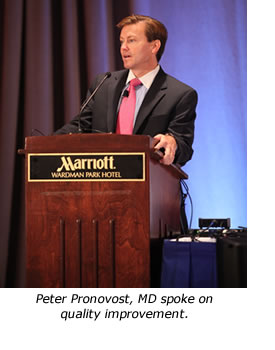 The first speaker of the day was Dr. Peter Pronovost who is professor of Anesthesiology and Critical Care at Johns Hopkins Medical Center. He is also among TIME magazine's top 100 most influential persons of 2008. His speech was engaging and a passionate description of decades of efforts in quality improvement and saving lives. He opened with the question “How many people die preventable deaths?” He promoted the idea that for decades, the legislation has been dictated by the medical profession in the shape and form of various laws, agencies and plans. The actions that will make the real difference in the lives of patients need to come from physicians themselves. No one else can implement the changes needed to minimize these errors and complications.
The first speaker of the day was Dr. Peter Pronovost who is professor of Anesthesiology and Critical Care at Johns Hopkins Medical Center. He is also among TIME magazine's top 100 most influential persons of 2008. His speech was engaging and a passionate description of decades of efforts in quality improvement and saving lives. He opened with the question “How many people die preventable deaths?” He promoted the idea that for decades, the legislation has been dictated by the medical profession in the shape and form of various laws, agencies and plans. The actions that will make the real difference in the lives of patients need to come from physicians themselves. No one else can implement the changes needed to minimize these errors and complications.
According to reports published in the New England Journal of Medicine, pay for performance is not improving medical care. With time, the rate of sentinel events is actually rising. Dr. Pronovost asked people to write down the words “I WILL”, encouraging everyone to take this message home and to implement changes at their home institute. Three values - humility, love and courage - are critical to bringing change. Dr. Pronovost suggested that the policy should be based upon good data. He gave an example of a study in Holland, which showed that by painting a fly in the urinals of the men’s bathroom, the level of cleanliness in restrooms drastically improved. This finding led to increased utility of this visual aid and improved sanitation in men’s rooms.
Dr. Pronovost then talked about a little girl, Josie, who died at Johns Hopkins under his care due to a line infection. After one year, Josie’s mother asked Dr. Pronovost if the hospital was any safer than the day Josie died. Dr. Pronovost told her that he wished it was but the answer was “No”. Since that time, Dr. Pronovost identified a five-item checklist, to be implemented prior to placement of all central lines. Since implementation of the checklist, central line infection rates decreased from 30% to 5%. With the addition of an external check (RN’s ability to reinforce physician adherence to the checklist), the rate was further decreased to 2%. At this point, the checklist was implemented in the operating room, further decreasing the rate of infections to 1%. Finally, by evaluating the further need for the catheter each day, the rate of catheter infection fell to almost 0%.
In partnership with the Michigan Hospital Association, the morbidity and mortality due to catheter-related infection soon was brought to a minimum in the state of Michigan. This success came after overcoming significant resistance from local opposition. Hence the values of humility, love and courage came into play. As a consequence, the American Hospital Association partnered with Dr. Pronovost with the objective of implementing this checklist nationwide.
At this point, Dr. Pronovost introduced two important terms: CUSP (comprehensive unit based safety program) and TRiP (translating research into practice). He emphasized the idea of TRiP by summarizing the central line checklist created at Johns Hopkins. The checklist included the following five steps; wash hands, clean skin with chlorprep, avoid femoral site, use barrier precautions, and ask daily if the patient actually needs the central venous catheter. These checklists must address local needs, hence they may be different at different locations to address local needs. He encouraged physicians to identify local barriers to implementation. A real cultural change is required, e.g. nurses need to be supported to help implement checklists, all attempts must be made to eliminate defects (failures to follow checklist/plan) and attention must be paid to local barriers.
Below are some of the strategies Dr. Pronovost mentioned during his talk:
- As a routine, everyone must ask the following questions: Is what we are doing helping? Is our practice addressing the concern. Are antibiotics being given in a timely fashion? At an appropriate dose? Is the right antibiotic being given?
- There are four acts of implementation: Engage, Educate, Execute & Evaluate.
- One important aspect of ensuring safety is everyone’s commitment to zero. This includes the CEO, unit leaders and staff of individual units. The changes should be easy to follow (make sure equipment and implementation is practical and available).
- Program should start with clear goals and work backwards. The program should have goals, measures, resources, skill and accountability at every level.
These programs must be led by intrinsically motivated clinicians and should focus on technical and adaptive work. Clinicians must believe that the problem is important and that THEY can solve it. Peer-to-peer review with ruthless honesty as well as maintaining confidentiality helps to find cracks in the system. Hopefully, we can all commit to zero, and by TRiP (Translating Research into Practice), we will be able to tell Josie's mother that our hospital is now a safer place to heal.
Session I: Providing Safe Perioperative Care to Children Around the World
Reviewed by Cheryl K. Gooden, MD
Mount Sinai Medical Center
The Thursday morning panel moderated by Giorgio Ivani, MD (Regina Margherita Children’s Hospital, Turin, Italy) provided an overview of the state of anesthesia safety, perioperative issues, considerations in the training of anesthesia providers, current and future measures to improve the safety of pediatric anesthesia in low and middle income countries. The first speaker, Isabeau Walker, MB (Great Ormond Street Hospital NHS Trust, London, UK) presented “Improving the Safety of Pediatric Anesthesia in Low-Income Countries.” Anesthesia safety has served as a model for overall patient safety. It has been suggested that several factors play a role in promoting anesthesia safety and these include training, standards, equipment, drugs, simulation training and quality improvement. High income countries have the ability to invest healthcare dollars to improve these factors. For low-income countries, it is quite the opposite.
Dr. Walker highlighted the results of a meta-analysis (Bainbridge et al. Lancet 2012; 380: 1075-8) that examined perioperative and anesthetic-related mortality in developed and developing countries. It comes as no surprise that perioperative and anesthetic-related mortality has declined significantly in developed countries. On the contrary, in developing countries the mortality rate is not improving. What does this really mean? Perioperative and anesthetic-related mortality is two to three times higher in developing countries. In a global-minded society, the disparity observed in the rates of mortality between developing and developed countries deserve to be addressed.
Later, Dr. Walker explored other factors to consider in the disparity in mortality rates between developing and developed countries. These factors include economics, shortage of essential healthcare workers, access to surgery, and the severity of disease. She compared the number of doctors trained per year in the United Kingdom (UK) with Ethiopia. For example, in the UK with a population of 60 million, approximately 6,000 doctors are trained per year. In Ethiopia, where there is a population of 85 million, only 3,000 doctors are trained per year. There is no doubt that the number of trainees per year impacts the overall equation towards improving healthcare.
In addition, Dr. Walker presented her findings of a survey conducted in south-western Uganda. She led a team that examined pediatric surgery rates, as well as determined whether surgical facilities and the workforce met World Health Organization (WHO) standards. The results of the survey indicated that access to pediatric surgery was inadequate. No hospital met WHO standards for surgery. Of note, in the facilities where major surgery was performed, 46% had pulse oximeters in the OR and 7% in the PACU.
Dr. Walker concluded her presentation by offering some solutions to improve the safety of pediatric anesthesia in low-income countries. First, there is a need to improve education through access to available educational resources. Then, there is the continued effort of WFSA to train anesthesiologists. Finally, the maintenance of long term partnerships with visiting clinical teams will have a positive impact on patient safety.
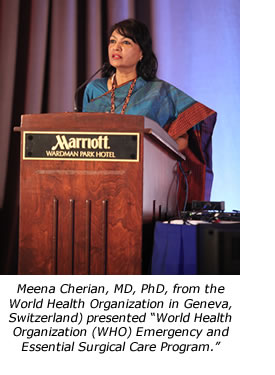 The second speaker, Meena Cherian, MD, PhD (World Health Organization, Geneva, Switzerland) presented “World Health Organization (WHO) Emergency and Essential Surgical Care Program.” In 2004, the WHO Emergency and Essential Surgical Care (EESC) program was established to provide life-saving surgical care in areas of the world where the burden is high, access is low, and the disparity is enormous. There is a huge need for anesthesia providers to help with efforts to reduce the global burden of surgical disease. This is particularly the situation in first-referral level healthcare facilities.
The second speaker, Meena Cherian, MD, PhD (World Health Organization, Geneva, Switzerland) presented “World Health Organization (WHO) Emergency and Essential Surgical Care Program.” In 2004, the WHO Emergency and Essential Surgical Care (EESC) program was established to provide life-saving surgical care in areas of the world where the burden is high, access is low, and the disparity is enormous. There is a huge need for anesthesia providers to help with efforts to reduce the global burden of surgical disease. This is particularly the situation in first-referral level healthcare facilities.
The following are important statistics that relate to the global-state of surgery:
- Approximately 234 million surgeries are performed worldwide
- 11% of the global burden of disease can be treated with surgery
- Two billon people have no access to basic surgical care
- The world’s poorest third get 3.5% of surgeries
- The world’s richest third get 73.6% of surgeries
The WHO Integrated Management for Emergency and Essential Care tool kit was developed for use by policy-makers and healthcare providers, in low income countries. The purpose of the toolkit is to provide WHO recommendations for minimum standard in emergency, surgery, trauma and anesthesia at first-referral level healthcare facilities.
Dr. Cherian concluded her presentation with the question, “What can we do?” She highlighted a number of areas in which help is needed. These areas include policy-making, research, training, developing centers of excellence, advocacy, quality and safety. She alluded to the fact that progress is being made in the OR in these low-income countries. It is important to keep in mind that basic anesthesia is a crucial component of primary healthcare.
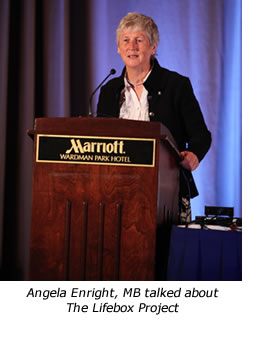 The final speaker in this panel, Angela Enright, MB (University of British Columbia, Victoria, Canada) presented “The Lifebox Project.” The inception of the Project was in 2004 at WFSA Paris. The goal of the Project was that pulse oximetry would become standard in ORs worldwide. The premise of the Project was that the use of pulse oximetry increased safety. That being said, pulse oximetry devices needed to be both affordable and well constructed. In addition, it would be essential to educate providers about the use of oximetry. Through the Lifebox Project, over 3,000 pulse oximeters have been delivered to ORs in 70 countries.
The final speaker in this panel, Angela Enright, MB (University of British Columbia, Victoria, Canada) presented “The Lifebox Project.” The inception of the Project was in 2004 at WFSA Paris. The goal of the Project was that pulse oximetry would become standard in ORs worldwide. The premise of the Project was that the use of pulse oximetry increased safety. That being said, pulse oximetry devices needed to be both affordable and well constructed. In addition, it would be essential to educate providers about the use of oximetry. Through the Lifebox Project, over 3,000 pulse oximeters have been delivered to ORs in 70 countries.
Dr. Enright emphasized that all of us have a role with Lifebox. She gave the following suggestions for our involvement with Lifebox:
- Can you estimate the oximetry gap somewhere?
- How can we get oximeters to where they are needed?
- Can you fundraise?
- Do you know someone who might support the project?
- Spread the word – publicity, lectures
- Not just anesthesiologists…
More details about Lifebox can be obtained at www.lifebox.org
Session II, Thursday IAPA
Reviewed by David Polaner, MD, FAAP
Children's Hospital of Colorado
University of Colorado School of Medicine
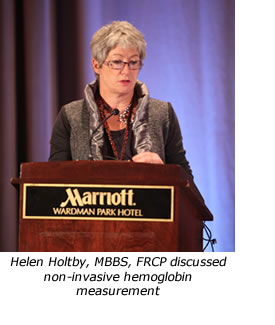 The second session on Thursday, moderated by Shoichi Uezono, MD (Jikei University, Tokyo, Japan) was focused on the use of non-invasive technology for monitoring and data analysis. First, Helen Holtby, MBBS, FRCP (Hospital for Sick Children, Toronto, Canada) discussed non-invasive hemoglobin measurement. This technology uses spectrophotometry- the quantification of monochromatic light absorbed as it passes through a known substance- to continuously determine the hemoglobin concentration in real time. By solving the Lambert-Beer equation, which states that the absorption of light intensity passing through a substance is dependent on the length of the optical path, the absorption coefficient of the substance, and its molar concentration, the hemoglobin concentration can be quantified.
The second session on Thursday, moderated by Shoichi Uezono, MD (Jikei University, Tokyo, Japan) was focused on the use of non-invasive technology for monitoring and data analysis. First, Helen Holtby, MBBS, FRCP (Hospital for Sick Children, Toronto, Canada) discussed non-invasive hemoglobin measurement. This technology uses spectrophotometry- the quantification of monochromatic light absorbed as it passes through a known substance- to continuously determine the hemoglobin concentration in real time. By solving the Lambert-Beer equation, which states that the absorption of light intensity passing through a substance is dependent on the length of the optical path, the absorption coefficient of the substance, and its molar concentration, the hemoglobin concentration can be quantified.
While this is relatively straightforward in vitro, one must make several assumptions in vivo. Many potential sources of error exist, including the variable length and path that the light takes through tissue (the patient must be >4kg); the presence of osteoporosis or low calcium in bone, low perfusion pressure, and motion artifact. In addition, both cyanotic heart disease and hyperoxia may affect accuracy. It is not known if hemoglobinopathies are a confounding factor, although some date exist to suggest this is not so. The technology tries to minimize the errors by using multiple wavelengths and using complex algorithms to analyze multiple sums of the transmission data. There are currently two devices available: the Masimo SET (Masimo, Inc.) and the OrSense NMB2000 (Nes Ziona, Inc.)
There are obvious benefits to this technology, including decreased blood sampling and need for arterial access and the potential for the real time detection of sudden unsuspected blood loss. Data in adults suggest reasonable precision with a 2-10% data acquisition failure rate. Precision suffered and variability increased during conditions of poor perfusion. There are seven studies in children to date, suggesting a precision of better than 2% variance from blood hemoglobin measurement and bias of less than 1%, but none have yet been subject to peer review- all are abstracts. Outcome studies have not yet been adequately performed. A Bland-Altman analysis in one adult study suggested an agreement with blood-measured values within 1-2gm/dl.
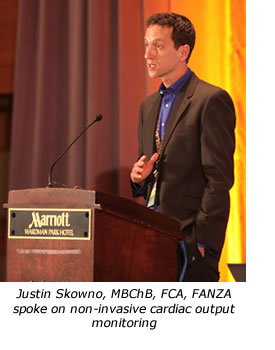 Justin Skowno, MBChB, FCA, FANZA (Children’s Hospital at Westmead, Australia) presented an informative talk on non-invasive cardiac output monitoring. Although we commonly measure oxygen content with oximetry, the parameter we really want to know is cardiac output, or more precisely, the ADEQUACY of oxygen delivery to the tissues (DO2=CaO2 x CO). The obvious reference standard can be achieved in animal models with flow probes around the aorta and pulmonary artery, and in humans direct Fick and thermodilution methods can measure cardiac output, but accurate non-invasive, easy to use and economical methods would be preferable and permit wider application.
Justin Skowno, MBChB, FCA, FANZA (Children’s Hospital at Westmead, Australia) presented an informative talk on non-invasive cardiac output monitoring. Although we commonly measure oxygen content with oximetry, the parameter we really want to know is cardiac output, or more precisely, the ADEQUACY of oxygen delivery to the tissues (DO2=CaO2 x CO). The obvious reference standard can be achieved in animal models with flow probes around the aorta and pulmonary artery, and in humans direct Fick and thermodilution methods can measure cardiac output, but accurate non-invasive, easy to use and economical methods would be preferable and permit wider application.
There are several non-invasive methods currently available:
- Electrical methods, including bio-impedance, electrical velocimetry, and bioreactance all measure beat to beat changes in thoracic electrical properties, which is then used to calculate stroke volume. Several studies in infants and children have shown reasonable correlation with the Fick standard.
- Esophageal doppler ultrasound measures the velocity time interval, and calculates or measures cross sectional area. For accurate results one must look at the center of the aortic flow, and measurements can be confounded by phase errors.
- With pulse contour or arterial waveform methods mathematical analysis of the waveform calculates pressure/ time, which is then converted to volume/ time. Several assumptions are potentially problematic: aortic compliance, capacitance, and systemic vascular resistance all can be confounding variables that are not easily accounted for. Furthermore, the wide range of these values in pediatric patients of different ages and sizes is problematic, and they have not yet been adequately validated in children.
- Near infrared spectrometry (NIRS) measures tissue oxygen delivery in venous blood, and thereby reflects the adequacy of O2 delivery. Interpretation can be difficult, but it can be used in many tissues, including brain. This is not a measure of cardiac output, but rather an index of tissue oxygen delivery.
Problems exist with all of these technologies, especially in establishing the linkage between the measured value and the actual stroke volume. They all suffer from potential errors in:
- linearity
- calibration range: all devices are calibrated under conditions of normal physiology
- market driven adoption versus actual evidence of value and accuracy (the latter, especially for outcomes, is virtually non-existent)
- interpretation and physician knowledge: one must understand both the technology and physiology well to properly user the data.
With more widespread use and better understanding of the limitations of these devices, clinicians can develop better knowledge of the physiology of shock from measurement, not just from clinical assumptions.
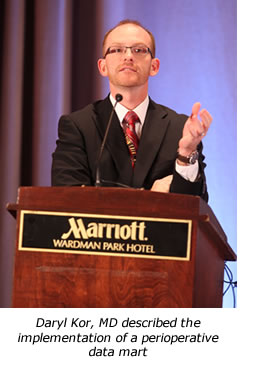 The final talk of the session was delivered by Daryl Kor, MD (Mayo Clinic, Minnesota, USA) and described the implementation of a perioperative data mart, and how the burgeoning world of electronic anesthesia records can be utilized to improve care. Anesthesia information management systems (AIMS) are now available in almost 50% of US OR’s. While many institutions (and vendors) view these systems as tools primarily for documentation and billing - little more than computerized paper records - their ultimate value lies in the leveraging of the data for research and to improve and enhance care. An ideal AIMS would use the vast quantities of multivariate data for research, patient and institutional management, and real-time decision support.
The final talk of the session was delivered by Daryl Kor, MD (Mayo Clinic, Minnesota, USA) and described the implementation of a perioperative data mart, and how the burgeoning world of electronic anesthesia records can be utilized to improve care. Anesthesia information management systems (AIMS) are now available in almost 50% of US OR’s. While many institutions (and vendors) view these systems as tools primarily for documentation and billing - little more than computerized paper records - their ultimate value lies in the leveraging of the data for research and to improve and enhance care. An ideal AIMS would use the vast quantities of multivariate data for research, patient and institutional management, and real-time decision support.
Modern perioperative anesthesia care suffers from an overload of data from different devices, which can result in confusion, false alarms and alarm fatigue. Data must be managed, processed and applied, and finally presented in a meaningful way to be useful, and a ”smart” AIMS can help achieve that goal.
The data mart is an access layer that lets the clinician and researcher get information out the data warehouse and apply it. The data mart relies heavily on clinical content experts who can decide what is important and what parameters can predict complications and adverse (or good) outcomes. It is the content experts, not the computer or database experts, who possess the understanding of physiology and pathology that enables them to decide what issues and intraoperative variables are important for decision support. They direct the structure and output of the mart to clean the data and, using active algorithms, to display meaningful information to the clinician at the bedside.
Once a department develops decision support tools based on algorithmic rules that analyze multivariate data, the system can automatically send out alerts and advice to the clinician in real time. For example, at Mayo a “data sniffer” was implemented that looked for ventilatory parameters associated with the development of ventilator induced lung injury (VILI); when those parameters were breached a high tidal volume alert was triggered and displayed to the anesthesiologist on the AIMS screen. This resulted in lowering of intraoperative delivered tidal volumes and a dramatic reduction of VILI over a two-year period. Similar processes can be applied to OR management and resource allocation. The future of medical informatics lies with these kind of advanced uses of the data that we are already collecting.
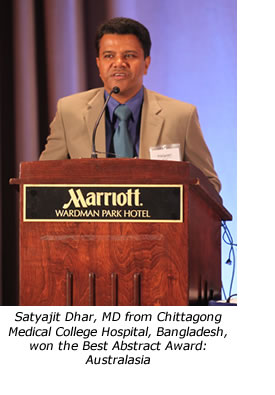 Katsuyuki Miyasaka, MD (St. Lukes School of Nursing, Tokyo, Japan) introduced the best abstract award from Australasia, which was awarded to Dr. Satyajit Dhar (Chittagong Medical College Hospital, Bangladesh). Dr. Dhar presented his study Cost effectiveness of an outreach surgical camp for cleft lip and palate in Bangladesh. Clefts remain commonly untreated in rural Bangladesh, and surgical resources are only available in urban tertiary care centers that are not easily accessible to the impoverished rural population. Between 2000 and 2010 Dr. Dahr’s group established 30 outreach camps organized in rural district hospitals. While the existing district hospital infrastructure was used, medical and support staff from tertiary care centers were brought in to provide the care, rather than transporting the patients. 767 patients were treated without significant morbidity. Because of the overall savings in transport, food, lodging costs, and loss of income, total medical care expenditures were less than half of what would have been incurred by bringing patients to a tertiary hospital. This highly effective and efficient model can be exported to other developing countries.
Katsuyuki Miyasaka, MD (St. Lukes School of Nursing, Tokyo, Japan) introduced the best abstract award from Australasia, which was awarded to Dr. Satyajit Dhar (Chittagong Medical College Hospital, Bangladesh). Dr. Dhar presented his study Cost effectiveness of an outreach surgical camp for cleft lip and palate in Bangladesh. Clefts remain commonly untreated in rural Bangladesh, and surgical resources are only available in urban tertiary care centers that are not easily accessible to the impoverished rural population. Between 2000 and 2010 Dr. Dahr’s group established 30 outreach camps organized in rural district hospitals. While the existing district hospital infrastructure was used, medical and support staff from tertiary care centers were brought in to provide the care, rather than transporting the patients. 767 patients were treated without significant morbidity. Because of the overall savings in transport, food, lodging costs, and loss of income, total medical care expenditures were less than half of what would have been incurred by bringing patients to a tertiary hospital. This highly effective and efficient model can be exported to other developing countries.
Session III – Interactive Clinical Case Discussions
Reviewed By Erin Williams, MD
Assistant Professor, Pediatric Anesthesiology
Texas Children's Hospital
Baylor College of Medicine
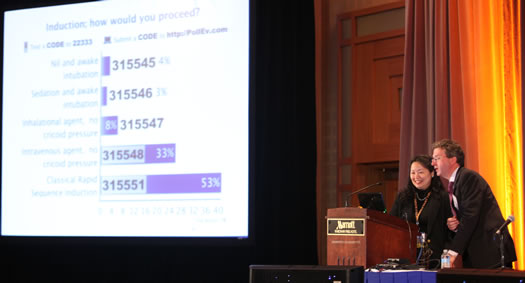
Drs. Serene Lim and Andrew Davidson monitoring the audience response system.
“On your mark, get set, ready…go!!!!!" If anyone is a fan of action-packed, fast paced, exciting, interesting conferences, session III of the IAPA would be their favorite session.
For the first time in SPA history, the presenters incorporated a new innovative technology which allowed LIVE audience participation. The presenters were Dr. Serene Lim of Singapore, Dr. Snehalata Dhayagude from India and Dr. Walid Habre from Switzerland.
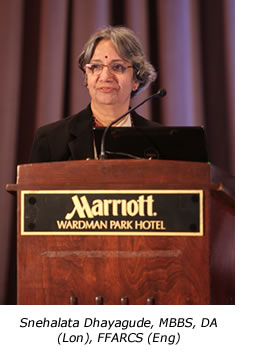 This session involved one case stem. Each presenter discussed a particular aspect of the medically challenging case. The audience was allowed to answer questions regarding the management of the patient in the case stem. The questions were asked in a multiple-choice fashion. Each answer (A through E) had a particular code assigned to it. This code could be “texted” to a predetermined number, and once the text was sent, the answers from the audience would appear on the screen in a live format.
This session involved one case stem. Each presenter discussed a particular aspect of the medically challenging case. The audience was allowed to answer questions regarding the management of the patient in the case stem. The questions were asked in a multiple-choice fashion. Each answer (A through E) had a particular code assigned to it. This code could be “texted” to a predetermined number, and once the text was sent, the answers from the audience would appear on the screen in a live format.
This was extremely insightful because it gave the audience members an active voice. This also gave the attendees the opportunity to evaluate other audience member’s thoughts and or modes of practice.
The medically challenging case involved a 2 kg baby born at 34 weeks gestation; at 24 hours the baby developed bilious vomiting. The case focused on induction, fluid management, and ventilation of this patient.
Each subtopic of this case was addressed in the following sequence – 1) questions to audience with response 2) review of the literature 3) re-query the audience 4) questions.
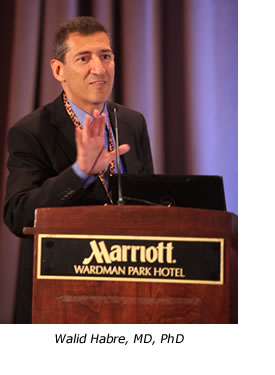 Given the live feedback from the audience, participants were enlightened as to whether their answer was in the majority, the minority or somewhere in the middle. Additionally, once the literature review occurred, audience members were asked the SAME questions. It was fascinating to see the audience’s response change after the quick review of the literature.
Given the live feedback from the audience, participants were enlightened as to whether their answer was in the majority, the minority or somewhere in the middle. Additionally, once the literature review occurred, audience members were asked the SAME questions. It was fascinating to see the audience’s response change after the quick review of the literature.
After the rapid fire interactive case scenario the audience members were reminded that cricoid pressure in the neonate is NOT always beneficial, an ideal fluid in this patient might be an isotonic electrolyte solution with 1% glucose, the lowest acceptable hemoglobin for the neonate prior to going to the operating room was not clearly defined, and when treating the acute desaturation in pulse oximetry in the this patient the most effective initial maneuver is to mass recruit the lung and apply PEEP and increase FiO2.
Finally, the winner of the Best Oral Abstract from Europe was Dr. Ivana Budic. Her abstract was “The Influence of Antioxidant Property of Anesthetics on Erythrocyte Lipid Peroxidation as a Response to H2O2 induced Stress After Ischemia Reperfusion Injury which showed the level of erythrocyte lipid peroxidation was more expressed with regional and volatile anesthetics compared to continuous propofol infusion.
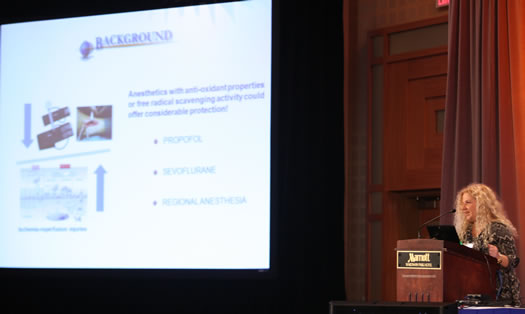
The winner of the Best Oral Abstract: Europe was Ivana Budic, MD, PhD.
Given the exciting interactive session and the interesting abstract, we look forward to next year’s conference!
Session IV: International Advocacy for Education and Safety
Reviewed by Connie Monito, MD
Johns Hopkins University
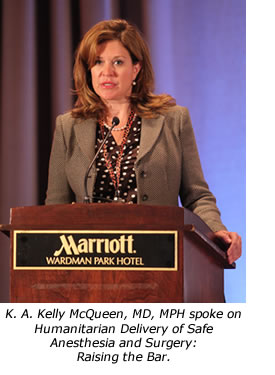 The fourth session,” International Advocacy for Education and Safety” was moderated by Dr. Shobha Malviya (CS Mott Children’s Hospital, Ann Arbor, MI). Dr. K. A. Kelly McQueen (Phoenix Children’s Hospital, AZ), a Fellow at the Harvard Humanitarian Initiative, began the session with a talk titled “Humanitarian Delivery of Safe Anesthesia and Surgery: Raising the Bar.” Dr. McQueen started her talk by informing the audience that across the world 2 billion people lack access to needed surgery. In light of this need, humanitarian delivery of surgery, involving a contribution of time from surgeons and anesthesiologists from developed countries, has become more prevalent since World War II. However, while surgeons may want to operate, it is important to remember that in order to do no harm all components need to be available before international teams perform elective surgery. These “minimum needs for surgery” include adequate water, availability of blood, sterilization, necessary medications and equipment, appropriate anesthesia and surgical personnel, and the ability to provide adequate perioperative care and post-operative follow-up.
The fourth session,” International Advocacy for Education and Safety” was moderated by Dr. Shobha Malviya (CS Mott Children’s Hospital, Ann Arbor, MI). Dr. K. A. Kelly McQueen (Phoenix Children’s Hospital, AZ), a Fellow at the Harvard Humanitarian Initiative, began the session with a talk titled “Humanitarian Delivery of Safe Anesthesia and Surgery: Raising the Bar.” Dr. McQueen started her talk by informing the audience that across the world 2 billion people lack access to needed surgery. In light of this need, humanitarian delivery of surgery, involving a contribution of time from surgeons and anesthesiologists from developed countries, has become more prevalent since World War II. However, while surgeons may want to operate, it is important to remember that in order to do no harm all components need to be available before international teams perform elective surgery. These “minimum needs for surgery” include adequate water, availability of blood, sterilization, necessary medications and equipment, appropriate anesthesia and surgical personnel, and the ability to provide adequate perioperative care and post-operative follow-up.
Focusing on these needs, Dr. McQueen reminded the audience that things we take for granted, such as electricity, are not always consistently available in low income countries, and this may have a profound impact on the ability to provide safe care. For example, 300 liters of clean water is necessary per surgery per day. Oxygen is generally obtained by utilizing oxygen concentrators, but these require working electricity. Blood banking is frequently not available as there may be no refrigeration, so in some locales needs are met via a “living blood bank.” In addition, supply availability is often sporadic as disposables are reused and may be clean but not sterile. Equipment may be old or broken, and the ability to repair available equipment may be limited. From an anesthetic perspective, essential medications include general anesthetics and analgesics. Inhalational anesthesia in developing countries often involves halothane, rarely sevoflurane, and occasionally ether. When inhalational anesthesia is not an option, ketamine is frequently available to provide general anesthesia. Local anesthesia is often administered using lidocaine. However, systemic pain medications, including morphine, can be of limited availability and in some places patients may need to supply their own post-op pain medications. Muscle relaxants, on the other hand are not considered essential, and may increase risk in places where the ability to ventilate patients is not available. In these locales surgery cannot be viewed as “the end game” due to the risk of post-operative complications and the need for appropriate follow-up. Hence, necessary personnel must include triage, nursing, anesthesia, and surgeons who can care for patients as needed throughout the perioperative course.
Regarding challenges to surgery and anesthesia she stated that it is important to understand that surgery and anesthesia in austere surroundings are not intuitive, and to identify anesthesia and surgical skills necessary for missions. While physicians rely on high tech equipment at home, a more hands on approach when monitoring is limited is essential. Nevertheless, the provision of minimal safe monitoring, e.g., routine pulse oximetry, is important as well. Finally, data needs to be collected to identify current deficiencies in the provision of care with the ultimate goal being creation of a set of standards to be maintained by those practicing in the humanitarian setting.
 Dr. Donald C. Tyler (Children’s Hospital of Philadelphia, PA) continued the session speaking on “Audits, Incidents, and QI Databases: Lessons and Opportunities for International Cooperation.” Dr. Tyler started his presentation by asserting that while scientific knowledge is an essential component of medical education, learning is frequently experiential. A number of avenues exist that allow us to speed up this learning, including direct communication between physicians, departmental conferences, and participation in national and international databases. Dr. Tyler reviewed the seminal work of Jeffrey Cooper, Ph.D., in the 1970’s in which he analyzed adverse anesthetic events at a number of hospitals in Boston via interviews and case reviews and found that many were caused by human error. More useful information was provided by Dr. Fred Cheney and colleagues in the ASA Closed Claims Project, a collection of anesthesia-related adverse outcomes extracted from closed malpractice claims against anesthesiologists. By reviewing these cases, this group was able to identify a number of important risk factors for adverse anesthetic outcomes, and their work led to changes in practice including the routine use of end-tidal C02 monitoring. Finally, in the field of pediatric anesthesia, the Perioperative Cardiac Arrest Registry led by Dr. Jeffrey Morray and colleagues was able to identify problems in pediatric anesthesia, including cardiac arrests as a result of halothane administration and transfusion-related hyperkalemia in small infants. Currently, Wake Up Safe, an initiative organized by the Society for Pediatric Anesthesia, has continued this quality improvement process. Wake up Safe contains a registry of serious adverse events reported on a voluntary basis by 19 participating institutions. Problems identified include wrong side surgery, medications errors, and hyperkalemia. The goal of the initiative is to identify gaps in knowledge and find ways to reduce or eliminate harmful events. As helpful as databases can be, though, Dr. Tyler reminded the audience that they are not a cure-all. Rather, improving practice involved changes in behavior and systems. Finally, addressing areas for international cooperation, he stressed the need for physicians to work together to share solutions that work, to be involved in peer-to-peer learning, and to help develop a uniform language of quality, e.g., one in which we can all agree regarding what is “anesthesia related,” what is an “unexpected” ICU admission, and what is a “significant” respiratory or cardiac event.
Dr. Donald C. Tyler (Children’s Hospital of Philadelphia, PA) continued the session speaking on “Audits, Incidents, and QI Databases: Lessons and Opportunities for International Cooperation.” Dr. Tyler started his presentation by asserting that while scientific knowledge is an essential component of medical education, learning is frequently experiential. A number of avenues exist that allow us to speed up this learning, including direct communication between physicians, departmental conferences, and participation in national and international databases. Dr. Tyler reviewed the seminal work of Jeffrey Cooper, Ph.D., in the 1970’s in which he analyzed adverse anesthetic events at a number of hospitals in Boston via interviews and case reviews and found that many were caused by human error. More useful information was provided by Dr. Fred Cheney and colleagues in the ASA Closed Claims Project, a collection of anesthesia-related adverse outcomes extracted from closed malpractice claims against anesthesiologists. By reviewing these cases, this group was able to identify a number of important risk factors for adverse anesthetic outcomes, and their work led to changes in practice including the routine use of end-tidal C02 monitoring. Finally, in the field of pediatric anesthesia, the Perioperative Cardiac Arrest Registry led by Dr. Jeffrey Morray and colleagues was able to identify problems in pediatric anesthesia, including cardiac arrests as a result of halothane administration and transfusion-related hyperkalemia in small infants. Currently, Wake Up Safe, an initiative organized by the Society for Pediatric Anesthesia, has continued this quality improvement process. Wake up Safe contains a registry of serious adverse events reported on a voluntary basis by 19 participating institutions. Problems identified include wrong side surgery, medications errors, and hyperkalemia. The goal of the initiative is to identify gaps in knowledge and find ways to reduce or eliminate harmful events. As helpful as databases can be, though, Dr. Tyler reminded the audience that they are not a cure-all. Rather, improving practice involved changes in behavior and systems. Finally, addressing areas for international cooperation, he stressed the need for physicians to work together to share solutions that work, to be involved in peer-to-peer learning, and to help develop a uniform language of quality, e.g., one in which we can all agree regarding what is “anesthesia related,” what is an “unexpected” ICU admission, and what is a “significant” respiratory or cardiac event.
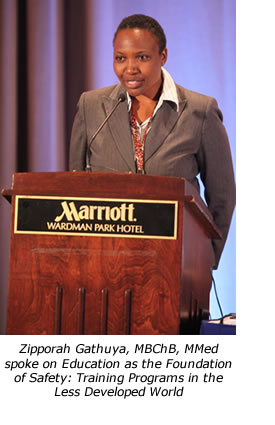 Dr. Zipporah Gathuya (Gertrude’s Children’s Hospital, Nairobi, Kenya,) concluded the session speaking on “Education as the Foundation of Safety: Training Programs in the Less Developed World.” Dr. Gathuya noted that throughout the world training is the backbone of acquisition and improvement of skills. In the past, training followed the paradigm of “see one, assist one, do one.” Currently simulation also plays an important role in training, however, the contribution of these two learning styles need to be balanced. She also noted that training in the developing world is often individually driven as there is no formal curriculum, and low availability of resources such as textbooks and journals. However, the need to train physicians and anesthesiologists is great as there is a significant “human resource gap.”
Dr. Zipporah Gathuya (Gertrude’s Children’s Hospital, Nairobi, Kenya,) concluded the session speaking on “Education as the Foundation of Safety: Training Programs in the Less Developed World.” Dr. Gathuya noted that throughout the world training is the backbone of acquisition and improvement of skills. In the past, training followed the paradigm of “see one, assist one, do one.” Currently simulation also plays an important role in training, however, the contribution of these two learning styles need to be balanced. She also noted that training in the developing world is often individually driven as there is no formal curriculum, and low availability of resources such as textbooks and journals. However, the need to train physicians and anesthesiologists is great as there is a significant “human resource gap.”
For example, in the USA there are 2.4 physicians per 1000 population, while in Africa physician availability ranges between 0.02/1000 in Malawi and 0.74/1000 in South Africa. This discrepancy has been magnified in past by the reality that once physicians have completed training they have frequently left their home countries to pursue better opportunities elsewhere. While Dr. Gathuya noted that one potential solution to improve access to care involves task shifting, e.g., teach non-anesthesiologists to provide safe anesthesia, she voiced the concern that this may involve advocating for the provision of a lesser quality of care. Hence, she reiterated that there remains a real need to train more physicians who will provide care in their home countries. This goal may be reached in part by international collaborations, World Health Organization initiatives, and, in our own field, pediatric anesthesia fellowships offered through the World Federation of Societies of Anesthesiologists at hospitals in Chile, India, Singapore, Tunisia, and Israel.
Keynote: IARS Lecture - SmartTots
Reviewed by Toyin Olutoye, MD, FAAP
Texas Children's Hospital
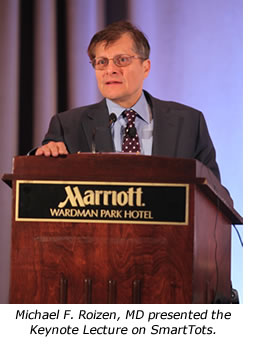 The keynote lecture, given by Dr. Mike Roizen, also the Wellness officer at Cleveland Clinic, kicked off the Friday morning session of IAPA. Dr. Roizen initially reviewed the history of the partnership between the International Anesthesia Research Society (IARS) and the United States Food and Drug Administration (US FDA), a collaboration which has culminated in the development of Smart Tots (Strategies for Mitigating Anesthesia Related Neurotoxicity in Children or Tots). He disclosed the initial statement released by Smart Tots which was three fold:
The keynote lecture, given by Dr. Mike Roizen, also the Wellness officer at Cleveland Clinic, kicked off the Friday morning session of IAPA. Dr. Roizen initially reviewed the history of the partnership between the International Anesthesia Research Society (IARS) and the United States Food and Drug Administration (US FDA), a collaboration which has culminated in the development of Smart Tots (Strategies for Mitigating Anesthesia Related Neurotoxicity in Children or Tots). He disclosed the initial statement released by Smart Tots which was three fold:
- The knowledge of anesthetic induced neurotoxicity is accumulating, but the mechanisms and significance are not yet identified.
- It is necessary to fund investigations centering around multiple aspects of anesthesia.
- If existing anesthesia is found to result in neurotoxicity, Smart Tots will foster the development of new guidelines and drug administration protocols.
The goal of Smart Tots also includes filling critical science research gaps to help ensure safe anesthesia for infants and kids undergoing anesthesia each year.
Dr. Roizen highlighted the original study by Dr. Todorovic in 2003 which initially suggested that a combination of midazolam, isoflurane and nitrous oxide in small animals led to neuronal death in the developing brain. He also mentioned recent studies by Wilder et al 2009 from Mayo Clinic and DiMaggio et al 2011 from Columbia University which suggested an association between anesthesia and learning disabilities, and the study by Brambrink et al 2012 from Oregon University which suggests anesthesia induced toxicity in non-human primates receiving ketamine. While N-methyl d-aspartate antagonists (NMDA) and gamma amino butyric acid (GABA) agonists are being implicated in anesthesia induced neurotoxicity, it is not clear if single or multiple anesthetic exposures is to blame.
The possible implications for our practice according to Dr. Roizen include: limitation of anesthetic exposure to certain anesthetics, shorter duration or number of anesthetics. Another question to consider is if we should delay elective surgery until age three or four years but it is unclear what the exact period of vulnerability is. Roizen explained that The Smart Tots leadership serves to provide administrative oversight, offer broad scientific expertise, guide scientific direction, analyze research data and outcomes, disseminate findings to inform clinical practice and also to help solicit funds.
The many different affiliates of Smart Tots including the American Academy of Pediatrics (AAP) and all other active participants and donors were mentioned.
Lastly, he gave an update on the recent request for research proposals by Smart Tots which resulted in 33 applications being reviewed and two awards being granted by the organization to Caleb Ing MD of Columbia University and Robert Block, PhD of the University of Iowa.
In closing, he navigated the Smart Tots website for the audience and encouraged the Society for Pediatric Anesthesia members to donate and support research in this area.
Anesthetics and the Developing Brain: Time for a Change in Practice?
Reviewed by Chris D. Glover, MD
Texas Children's Hospital
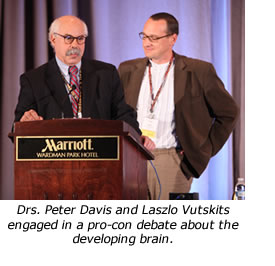 This review covers the Pro-Con Debate on Anesthetics and the Developing Brain moderated by Dr. Peter Davis (Children’s Hospital of Pittsburgh, PA).
This review covers the Pro-Con Debate on Anesthetics and the Developing Brain moderated by Dr. Peter Davis (Children’s Hospital of Pittsburgh, PA).
Dr. Laszlo Vutskits (University of Geneva, Switzerland) began the debate by giving a comprehensive presentation of the experimental and clinical data supporting the premise that exposure to commonly administered anesthetics lead to anesthesia induced neurotoxicity (AIN) and central nervous system dysfunction in young children.
Dr. Vutskits based his argument on these underlying principles:
- That the immature central nervous system is extremely sensitive to any kind of stimuli
- The functional role of neurotransmission in brain development is quite important
- Lab evidence pointing to anesthesia causing neurotoxicity
- Epidemiologic studies pointing to an association between early anesthesia exposure and altered long term neurocognition
Dr. Vutskits started his talk emphasizing how sensitive the immature central nervous system is to external stimuli. Even small periods of pharmacologic exposure could interfere with and significantly impact development of the immature brain. Examples supporting this include exposure of female rats to a single dose of androgen within the first five days of life resulting in impaired reproductive cycling. Imprinting that occurs with geese after hatching also supports this. A concept called critical period plasticity was defined as the period where anesthetic exposure risk is considered greatest and this period usually coincides with rapid synaptogenesis in cortical areas. Dr. Vutskits pointed out that the synaptogenic period varies between animal species; with rodents exhibiting synaptogenesis between 2-4 weeks postnatally while in humans it is thought this critical period occurs between birth and the first six months of life.
Dr. Vutskits then discussed the data supporting how anesthetic modulation of neurotransmission plays a role in dysfunction of neural development. The primary mechanism is thought to occur via inhibition of glutamatergic neurotransmission and/or potentiation via the GABA pathway resulting in impairment of development. This drug-induced impairment affects the balance between excitation and inhibition leading to altered information processing and has been pointed to as the potential mechanism for neurodevelopmental disorders like epilepsy, autism, and Rett’s Syndrome.
The third arm of his argument points to multiple animal models from worms to primates exhibiting developmental delay with anesthetic drug exposure during the development phase. Experimental animal data covered included experiments showing permanent functional impairment and cognitive decline in an immature rodent model when exposed to anesthetics over a six hour span. This has been further corroborated by experiments in which higher order animals like primates developed cognitive deficits after exposure.
With regard to early childhood exposure and altered neurocognition, Dr. Vutskits pointed to the cohort study from Mayo that suggests children with multiple anesthetic exposures before age 4 had an increased risk of developing learning disabilities. Further examination of the data from this study also suggests a correlation between multiple anesthetic exposures before age 2 to ADHD development later on in life.
While persuasive in some regards, Dr. Vutskits did point to major limitations in the data, which are listed below:
- The alternative to exposing infants to invasive procedures without anesthesia is unethical
- No evidence on which anesthetic agents are most neurotoxic
- No data on length of exposure
- No data on doses that cause neurotoxicity
- No human studies which define the period of high vulnerability
This was evinced further in the presentation by Dr. Tom Hansen (University of Southern Denmark, Denmark).
Dr. Hansen reported that while compelling, clinical correlation and causation remain difficult to prove. There seems widespread agreement with regards to histological evidence observed in anesthesia induced neurotoxicity, namely apoptosis and altered dendritic growth, but extrapolation to humans remains difficult as the clinical effects are vague. This is further compounded by the fact that apoptosis is a natural part of neural development.
Dr. Hansen summarized factors associated with anesthesia-induced neurotoxicity to include:
- Developmental age of the species at time of exposure
- High doses of anesthetics
- Duration of exposure.
With regard to vulnerability, Dr. Hansen reported that the vulnerable period in humans was unknown. He further argued that if we assumed the vulnerable period was associated with rapid brain development, this time period would encompass the period from birth to 28 weeks. Furthermore, Dr. Hansen presented the difficulty that exists in tracking neurodevelopment across animal species as well as pharmacodynamic issues across species. One noteworthy mention during the talk mentioned that rats by some accounts require a 100 fold higher dose of anesthetics to obtain a surgical plane of anesthesia.
Dr. Hansen then reviewed the literature as it exists currently. The Mayo Clinic study’s conclusion of repeated anesthetic exposures and development of learning disorders and or ADHD was countered with studies from DiMaggio and a Danish cohort study. Both of these studies point to a lack of a casual relationship between anesthesia exposure and brain dysfunction. The main limitations of all studies thus far are the inability to separate confounders (effects of surgery and morbidity associated with surgery) from the data.
In conclusion, Dr. Hansen did not deny apoptosis exists with anesthetic exposure. However, issues still remain with translation of animal data to humans and a clear lack of readily identifiable measures that can result from anesthesia exposure.
The second session was moderated by Dr. Bruno Marciniak (Lille University Hospital, France) and the discussion centered on the use of nitrous oxide in current practice. Dr. Victor Baum (University of Virginia, VA) acquitted himself well in this session arguing with himself on both the pros and cons of nitrous oxide use in practice or as his title states “the wind from the wings of angels or the devil’s flatus.” Nitrous is an NMDA antagonist, but its effects on the immature brain are unclear and it is considered both a neuroprotectant and neurotoxin.
A major advantage with nitrous oxide lies with its cost. It remains inexpensive and easy to manufacture as evidenced by an article from Popular Science in 1949.
Other advantages for use in the pediatric population were then summarized. It is odorless and tasteless. It has a rapid onset and offset. There are no issues with emergence or malignant hyperthermia. It maintains the hemodynamic status when used in conjunction with volatile agents. Dr. Baum also mentioned benefit obtained from the use of nitrous oxide in chronic pain patients.
Nitrous oxide has a long record of safe use, but potential issues complicate the use of this agent. Reasons for limiting the use of nitrous covers 3 broad areas involving the environment, the patients, and providers.
There remains an environmental concern with nitrous oxide use. Dr. Baum pointed out that not only is nitrous oxide flammable (and a great way to put salami into outer space as rocket fuel), it also remains as the single most important ozone depleting emission agent today.
Prolonged nitrous oxide exposure once thought to be safe has been shown to cause aplastic anemia with megaloblastic changes in those exposed over 4 hours. Dr. Baum also pointed to animal models, which revealed a decrease of 50% in the activity of methionine synthetase after a 30 minute exposure to nitrous oxide and a total absence of activity at 6 hours of exposure. Immunologic effects briefly touched on by Dr. Baum include immune suppression via direct bone marrow suppression and via inhibition of lymphocyte response. Cell mediated cytotoxicity and chemotaxis are also adversely impacted with nitrous oxide exposure. Another issue lies in its inhibition of nitric oxide mediated vasodilation, which can be potentially problematic in those with underlying vascular disease.
Dr. Baum advocated avoidance in those with homocystinuria and methylmalonic acidemia as reports have indicated a causal relationship between exposure to nitrous oxide and subsequent development of profound metabolic acidosis and death.
It remains quite difficult even with scavenging to adequately limit exposure to nitrous oxide of caregivers. An average measurement nitrous oxide with an LMA in place is 50 ppm, which is twice the NIOSH recommended guideline. This has resulted in potentially increased spontaneous abortion rates of caregivers with a relative risk of 1.48 via meta-analysis. Neuropathies have also been reported with repeated exposure to this agent with the vast majority of cases occurring with concentration of nitrous oxide at >50%.
Clinically Dr. Baum briefly discussed the ENIGMA trial that found less PONV in groups receiving less nitrous oxide, but the study was not adequately powered for that outcome.
In summary, Dr. Baum pointed to nitrous oxide’s many deleterious effects via its irreversible interaction with B12. Effects on the environment and in those with B12 deficiency warrant limiting patient exposure to this agent. However, for healthy patients, limiting exposure allows for hemodynamic stability, anxiolysis, and minimal environmental contamination. Caregiver exposure can be limited via scavenging and appropriate administration as well. This combined with a prolonged history of safe use seems to point that the use or disuse of nitrous oxide remains very much in the eyes of the caregiver.
Abstract Awards and the Role of Specialty Societies
Review by Rita Agarwal, MD, FAAP
University of Colorado
Best Oral Abstract: Africa/Middle East
Moderator: Hussein Abu-Khudair, MBBS (Jordan)
The best abstract from Africa/Middle East was presented by Dr. Mehdi, and called Comparison of Nasal Midazolam and Nasal Clonidine Premedication in Children. Laidi B, Amjed F, Jihene B, Fehmi T, Mehdi T, Sonia B Children Hospital, Tunis, Bab saadou, Tunisia.
In this study the authors compared sedation scores and face mask acceptance in children <25 kg and aged 1-6 receiving either 0.2mg/kg intranasal midazolam or 4ug/kg intranasal clonidine. Patients were taken to the operating room when their sedation score was higher than 1 (awake) or after 45 minutes. They found that while sedation scores were higher in the children receiving clonidine, face mask acceptance was better in the patients receiving midazolam. Time to onset and other parameters were similar in both groups as was crying with administration of the medication.
Best Overall Oral abstracts were awarded to Dr. David Moore for his work on developing a method to assess regional anesthesia competency. The abstract was
Establishing Regional Anesthesia Competency Utilizing a Novel Ultrasound-Guided Regional Anesthesia Simulation Model and Cognition Testing. Moore D, Ding L
Cincinnati Children's Hospital Medical Center, Cincinnati, OH, United States, Cincinnati Children's Hospital.
Dr. Moore and his colleagues has developed a unique ultrasound guided regional nerve stimulator that uses electrical circuits to provide real time feedback regarding needle placement. They studied it in 19 fellows at 0, 6 and 12 months, as part of a multiple modal evaluation of accuracy, efficiency and cognition. Their training paradigm covered both cognition and technical skills and the simulator had good to very good correlation between those who did well on the cognitive exam and the USGRA simulator.
The second prize went to Characterizing Better and Worse than Average Teaching of Resident Physicians. Haydar B, Charnin J, Baker K University of Michigan, Ann Arbor, MI, USA; Massachusettts General Hospital, Boston, MA, USA.
In this study, all evaluations of faculty by residents from over a two-year period were examined. A mean score given by each resident was calculated, and the evaluations that were significantly above or below their average scores were examined by the authors for common themes. There were recurring themes that were both positive (healthy balance between supervision and autonomy; using primary literature for teaching) and negative comments (becoming impatient, frustrated or angry with resident, speaking ill of other residents)
The last lecture of the morning was by Dr. Nigel Turner on the role of Specialty Societies in Safe Care. Dr. Tuner is form the Wilhemina Children's Hospital in Ultrecht, Netherlands and is the President of the European Society of Pediatric Anesthesiologist (ESPA).
He spoke about the importance of specialty societies helping to improve safety by providing education, information and training to everyone that cares for pediatric patients, including nurses, pharmacists etc. He also discussed the power that these groups bring to lobbying efforts on the behalf of children's care. Finally, he discusssed the unique ability of these groups to audit and create large databases.
He emphasized the importance of focusing on a few specific areas with the input of the general membership. One of the examples he used was that of QUIPSI (Qualitätsverbesserung in der Postoperatief Schmerztherapie – Infant). This is a system endorsed by ESPA that allows for collection and feedback to participating hospitals on post-operative pain and patient satisfaction.
Anesthesia Related Neurotoxicity Panel
Reviewed by Elizabeth S. Yun, MD
University of Wisconsin School of Medcine
On Saturday October 13, 2012, three researchers exploring the question of anesthesia neurotoxicity in the developing brain reviewed current research in this field.
The first speaker was Laslzo Vutskits, MD, PhD (University of Geneva, Switzerland). His lecture “Of Mice and Monkey: Neurotoxicity in Animals” reviewed animal data concerning anesthesia neurotoxicity. He noted that the earliest studies in this field were based on the effects of alcohol on the developing brain. Like alcohol, many anesthetic agents are also NMDA antagonists/ GABA receptor agonists, and rats exposed to these drugs showed significant apoptosis.
Furthermore, the amount of apoptosis depended on the age of the animal. The older the rat was at time of exposure, the less damage was noted in the animal’s brain. Theses early studies also noted behavioral deficits in rats. To see if these findings occurred in higher order animals such as primates, a new series of studies looked at rhesus monkeys exposed to various anesthetic agents like ketamine, midazolam and isoflurane. The monkeys experienced apoptosis and again, the apoptosis was more pronounced in the early stages of brain development.
These findings raised concerns about the effect of apoptosis on cognitive function. Primate studies showed that monkeys exposed to anesthesia at an early age had cognitive deficits even three years after the exposure. Recent animal studies are focusing on the effect of anesthetic agents on the formation of synapses during brain development. It appears that isoflurane exposure may lead to decreased synaptic contacts in the developing brain. Neuroapoptosis may indicate impaired synaptogenesis which may imply less brain function. Other animal research suggests that morphine has no effect on apoptosis or synaptic density.
In conclusion, new directions of research include looking at synaptogenesis and anesthesia in primates as a means of elucidating the molecular mechanisms behind this phenomenon, and how surgical exposure might influence this issue.
 Tom Hansen, MD, PhD (University of Southern Denmark, Denmark) presented the second lecture, Clear as Mud: Evidence for Neurotoxicity in Children. This lecture provided an overview of current animal and human research. He noted that apoptosis is an integral part of normal brain development and maintenance of the health of the multicellular organism.
Tom Hansen, MD, PhD (University of Southern Denmark, Denmark) presented the second lecture, Clear as Mud: Evidence for Neurotoxicity in Children. This lecture provided an overview of current animal and human research. He noted that apoptosis is an integral part of normal brain development and maintenance of the health of the multicellular organism.
However anesthesia induced apoptosis may be similar to fetal alcohol syndrome and not necessarily a normal part of development. While many animal studies have showed apoptosis with anesthetic exposure, he stated that it is difficult to see how these studies apply to humans. Many studies do not factor the effect of surgical stimuli and pain on the developing brain. The doses and anesthesia drug combinations used do not reflect common clinical practices. These studies do not control for respiratory, metabolic and hemodynamic variables.
When generalizing from animal models it is also difficult to determine the equipotent dosing of anesthesia drugs in humans and rats. Therefore this issue may be a toxicological instead of a pharmacological problem in animals. There is no clarity as to when the developing brain is most vulnerable to anesthesia in humans. At this time it appears that the postnatal day seven in rats and the third trimester in humans is the most vulnerable period since peak synaptogenesis occurs at this time. However this fact may be based on the false premise that brain development occurs uniformly. In humans, the studies are large observational cohort studies since this design is less expensive and more efficient compared to randomized controlled trials.
Studies performed in several centers in the US and Europe show that exposure to anesthesia at less than three years of age may lead to learning and behavioral disabilities, although the results are inconclusive. Studies in Denmark focusing on single exposure anesthesia for a specific surgery (inguinal hernia repair and pyloric stenosis) showed no statistically significant difference. The inherent flaws in many of these studies are the difficulty of separating out the effect of surgery on the developing brain and the problem of measuring relevant human outcomes. In conclusion, single dose exposure appears to have no effect while repeated doses may be related to ADHD and learning disabilities but that this was not necessarily a causal relationship. At this time there is no conclusive information to change current anesthesia practices.
The last speaker was Lena Sun, MD (Columbia University, NY) whose lecture, Prospective Studies: The Holy Grail reviewed the current human studies. For many of these studies, the outcomes examined included academic performance, learning disabilities and diagnosis of behavioral abnormalities like ADHD. Other factors included were anesthesia and surgical exposure, age, comorbidities, genetics, race/ethnicity, surgical indication and parental education.
At this time, the only randomized control study is the GAS study (General Anesthesia Safety). This multisite study randomizes infants having inguinal hernia repair into two groups-one group receiving a general anesthesia and a control group of infants receiving a regional anesthesia without any general anesthesia exposure. Patients enrolled were greater than 26 weeks and less than 60 weeks post conceptual age. At age two and five years, the subjects will undergo neuropsychological testing.
Two ambidirectional prospective cohort studies, where exposure occurs in the past but the outcomes are assessed prospectively are the PANDA and MASK study. The PANDA (Pediatric Anesthesia NeuroDevelopment Assessment) study looked at ASA 1 patients who had a single exposure to a general anesthesia at age less than 36 months and had an unexposed sibling within three years. These patients will receive neuropsychological testing at ages 8-13 years.
The MASK (Mayo Anesthesia Safety in Kids) study is a five-year study that will be enrolling patients. Subjects are identified as being born in Rochester Minnesota between 1994-2007 and had a general anesthesia before age three. One group consists of ages 7-11 years and the second group is 15-19 years. Within each group, 150 patients received one general anesthesia and 100 patients had multiple general anesthetics. The control group will be propensity matched except for not receiving a general anesthesia. All groups will receive a battery of neuropsychological testing between the years of 2012=2016 to see if there are any differences. The ideal study would be a prospective cohort study where the exposure to anesthesia is controlled and the patients followed in the future at periodic intervals.
However, this type of study is difficult to perform because of the large sample size needed, the expense, the long time interval between exposure and outcome, difficulty to reproduce the results. Results from the above studies are still pending and the ideal prospective study is not feasible at this time.
In conclusion, while there have been great strides in animal and human research, there are many unknowns yet to be figured out. At this time, there is no need to change practices until more information has been discovered.
An Experience With an International Scholar at IAPA
By Toyin Olutoye, MD, FAAP
Texas Children’s Hospital
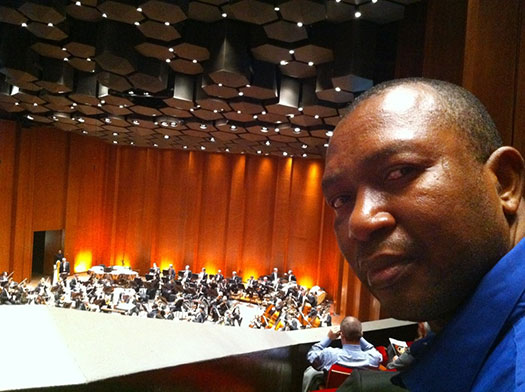
Dr. Obinna Ajuzieogu at a Houston Symphony concert.
Spending time with Dr. Obinna Ajuzieogu was enlightening for us both. Using halothane predominantly in his practice for induction of anesthesia, he marveled at how ubiquitous sevoflurane was in our operating rooms and how busy we were on a daily basis. He was also very impressed with our post operative management of children in PACU where morphine is ordered liberally for patients for pain management.
This differs from his practice where Diclofenac and ketamine administration are the norm. Through our discussions, I was able to appreciate the ongoing challenges anesthesiologists face in Nigeria ranging from lack of equipment geared towards the care of children to lack of proper education of anesthesia secondary providers. Nevertheless, at the end of the week, he was energized and ready to try new modalities of anesthesia care once he got back home.
It was nice to spend time with Obi socially as well. He attended my daughter’s last home volleyball game which they unfortunately lost, but he shared in the excitement of the last few minutes where we still thought we could win the game! Taking him to a megachurch in Houston-Lakewood church was a great experience for him, being able to worship in the huge stadium that he otherwise sees only on television was a treat. Having him over at my house for dinner and a small reception in his honor was a nice wind-down to his very busy week.
Apart from enjoying good food, he got to meet other practicing physicians in the Houston area, some of whom were also from his home country Nigeria. Dr. Pablo Motta took Obi to a professional soccer game in Houston, which he enjoyed; Dr. Laura Torres took him to an elegant dinner downtown and to the Houston Symphony, featuring international pianist Lang Lang performing Beethoven. Every night while he was in Houston, he was hosted by one of our TCH Anesthesiologists, building relationships and goodwill with all.
I look forward to keeping in touch with him and sharing ideas in the very near future.
My Passage To India
By Katherine R. Gentry, MD
Seattle Children's Hospital
Imagine your bladder being exposed to the open air, without its covering of skin, fascia, and muscles. Imagine having malformed genitals and malfunctioning sphincters that allow urine to dribble, your undergarments continually soiled. Imagine the embarrassment of perpetual stink, and the discomfort of frequent urinary tract infections. You might drop out of school, and you probably would not find a job. Marriage? Not likely either. Who would marry someone with faulty reproductive organs? If your defect is left unrepaired, imagine succumbing to malignancy at an early age—a tragic conclusion to a life spent feeling ostracized and ashamed.
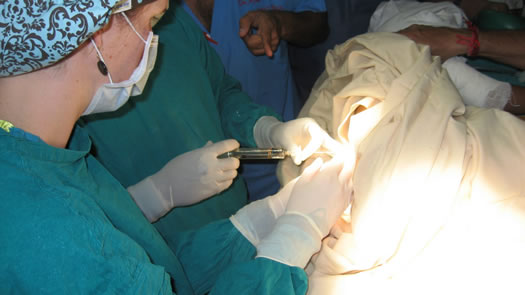
Dr. Katherine Gentry teaching epidural placement in India.
For children in the developing world with congenital urological anomalies such as bladder exstrophy, this is not an exercise in imagination—this is a reality.
My eyes were opened to the tragedies and triumphs of patients with congenital urological disease during my pediatric anesthesiology fellowship in 2011. An attending invited me to join her on a trip to India and I immediately signed on. I had always wanted to visit India and see what medical care was like there, so it was an easy decision. I also hoped that I might lay a foundation for more volunteer work throughout my career.
I am delighted to share my experience with readers of the SPA newsletter for several reasons:
- The presentation of children with bladder exstrophy left an indelible impression on my mind and in my heart.
- This trip was a stellar example of international collaboration and bi-directional education.
- Our experience demonstrates the benefits and challenges of utilizing regional anesthetic techniques in a resource-poor setting.
Our work took place at Civil Hospital in Ahmedabad, a large town in the state of Gujarat (in the western part of India, North of Mumbai). The volunteers from the U.S. included three attending pediatric urologists (Richard Grady of Seattle Children’s Hospital, Aseem Shukla of the University of Minnesota, and Dr. V Rama Jayanthi of Nationwide Children’s Hospital in Ohio); one attending anesthesiologist (Dr. Anjana Kundu of Seattle Children’s Hospital); and three trainees—a pediatric urology fellow, a urology resident, and myself.
Equally important participants in this program were the pediatric surgeons at Civil Hospital who hosted us, organized the patients, and performed patient follow-up. The local surgeons had been preparing for this “workshop” for months. All the potential patients were lined up waiting for evaluation on the day of our arrival, and a rapid triage process yielded an entire week’s surgical schedule within a few hours. In addition, patients treated the previous year were brought back to be seen by the visiting surgeons. Other integral team members were the anesthesiologists and the anesthesia residents at Civil Hospital. They graciously welcomed us into their operating rooms, eagerly accepted instruction on regional anesthesia, and provided invaluable overnight coverage for pain management issues.
There were both clinical and educational components to this mission. The clinical goal was to repair urologic anomalies such as bladder exstrophy, epispadias and hypospadias, urogenital sinus anomalies, and ureteral problems. The educational aims were to train local pediatric surgeons to perform such repairs, and to help the anesthesiologists develop a safe and comprehensive anesthetic plan that included good peri-operative pain management.
Children with bladder exstrophy born in developed countries typically receive their initial corrective surgery within the first few days of life. And in some metropolitan centers in India, these operations are also offered. However, there is a vast population without access to this level of care. Consequently, many children grow past infancy with significant malformations and suffer the consequences of social isolation and medical complications.
In India, there are no pediatric urologists. All pediatric urology operations are performed by either a pediatric general surgeon, or rarely, by an adult urologist. Therefore, one of the major thrusts of this project is to train pediatric surgeons and residents in the techniques of urological surgery so that they may perform these repairs independently.
Because major urologic reconstructive operations in children are not routinely performed at Civil Hospital, the anesthesiologists lack experience in these clinical situations as well. The current staffing model results in attending anesthesiologists rotating for two to four month periods among a variety of operative specialties with no subset of providers specializing in pediatric care.
The staff was eager to discuss the differences in pediatric anesthesia practice in our two countries. A typical induction at Civil Hospital involved whisking a crying child into the operating room after an IV was placed in the holding area. While a poorly fitting pulse oximeter was taped to the toe and ECG leads were pressed to the chest, a hard black rubber cone (frighteningly reminiscent of a gas mask) was placed over the nose and mouth to administer oxygen. The attending anesthesiologist would inject atropine, a barbiturate and a muscle relaxant while the resident mask-ventilated the patient and intubation proceeded. Inhalational inductions were a novelty despite the fact that sevoflurane is commonly used for anesthetic maintenance. After we introduced mask inductions for our cases, we were invited to give a brief lecture on induction techniques to the resident group. A lively discussion amongst the entire department followed.
As I’ve already mentioned, regional anesthesia was an important component of the anesthetic care we provided. The Indian attendings and residents were all excited about performing blocks in children. And as they learned how to safely place an epidural in a small child, I learned how to teach the procedure. As a current fellow and recent residency graduate, getting to be the instructor myself was a heady experience!
The cases (mostly open urological operations) lent themselves well to neuraxial techniques. Over the course of the week, thirteen children received epidural catheters, five received single-shot caudals, and one received a caudal catheter. We brought from home all the necessary supplies, because epidural kits were not readily available. After each procedure, the scrub tech would save the epidural needle so that it could be sterilized and re-used.
The benefits of regional anesthesia were the same as when it is performed in the developed world, and included a rapid emergence from general anesthesia (due to lower MAC requirements and less need for additional IV agents), an avoidance of opioid analgesics, and a resulting reduction in post-operative nausea and vomiting. However, the implications of these benefits were particularly impressive in this limited resource environment. Of note, opioid pain medications were reserved for treating cancer patients. It was only through a parent’s connection with an oncologist that a single vial of morphine was obtained for the entire week. Without the provision of regional anesthesia, our patients would have likely gone without adequate post-operative pain control.
In the recovery room, there were nine beds. Post-operative care was overseen by one nurse, who was rarely present in the ward. Her desk was located in the hallway and she directed a cadre of nursing students as they buzzed about, learning the ropes. The patients’ families (who camped out in the multi-bed ward) actually provided the majority of the post-operative care and support. What they lacked in skills they made up for in vigilance. On average, each child was watched by two or three adults.
The recovery room was sparsely equipped. There were no pulse oximeters and it was a chore to rig up a system for supplemental oxygen or suction. Detecting and managing hypoxia, hypoventilation, or airway obstruction was a challenge, and luckily no adverse respiratory events occurred. I attribute much of that success to the use of neuraxial anesthesia. The rapid emergence regional anesthesia afforded enhanced patient safety in the immediate post-op period and allowed for early assessment of block effectiveness. Epidurals and caudals proved to be reliable modalities for post-operative pain control that had a low risk of causing respiratory depression or airway obstruction.
However, there was a challenge to providing continuous neuraxial analgesia in this setting: a complete lack of infusion pumps. To solve this problem we created a schedule for regular bolus dosing and utilized adjuncts to enhance the quality and duration of our blocks. The on-call anesthesia residents evaluated the patients each night and administered boluses every six hours. These residents were eager to be of service, but it was clear that they had never before been trained in basic pain assessment tools. The fundamental concepts of pain evaluation and treatment became teaching topics that were revisited throughout the week.
The addition of adjuncts to the epidural solutions was vital to the success of our intermittent bolusing program. The most readily available additives were clonidine and surprisingly, tramadol, which is approved for neuraxial administration in India. Medications were expensive and vials were not considered single-use. Once a vial was opened, that medication was used in a series of patients to avoid waste and minimize costs. The system of bolus dosing and adjuncts worked. Most patients were comfortable throughout their post-operative stay, and the epidural catheters remained in place for forty-eight to seventy-two hours after surgery.
Patients come from all over India to receive treatment during this recurring workshop, and the local community has taken notice. The sparse conditions at Civil Hospital are the result of a chronic lack of money in this government-funded facility. However, the hosting and visiting surgeons have used the momentum generated by the project’s good press to arrange meetings with governmental representatives. As a result, the hospital has received increased financial support, which has led to the construction of a new trauma building and a new operative complex. When our volunteer group returned in 2012 they found themselves working in improved, remodeled facilities.
Medical missions can sometimes be criticized for creating a system of dependency and introducing change that is not sustainable. That is not the case here. The bi-directional educational mission, the commitment of all parties to hold the workshop annually, and the positive effects that this project has had on the host institution, make it a wholly admirable endeavor. Needless to say, I am grateful to have played a small part in one iteration of this mission and I hope to participate again in subsequent years.
One sixteen-year-old with exstrophy who received her primary repair during our visit stands out in my memory. A bright girl who loved to read, she had dropped out of school at the age of ten because she was sick of being teased and was embarrassed by her condition. Hours after her operation, she was already talking about going back to school. Her parents were considering, for the first time, that she might be able to get married. (Arranging a suitable match for your children is still very important in Indian culture). After years of suffering, a day’s journey to the hospital and a few hours of surgery, this family finally had hope.
Optimum Conditions: Why Health Metrics Should Matter to Anesthesiologists
By Nicholas J. Kassebaum, MD
Seattle Children’s Hospital
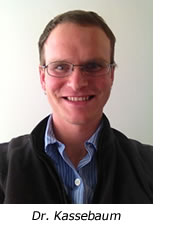 You’re on call. A 6-year-old girl presents to the ED with trouble breathing and takes an inhaler at home. She has a fever, is lethargic, and her parents tell you she hasn’t been feeling well for the past several days. History and physical examination are consistent with acute abdomen, and the general surgeons are called to perform an evaluation. Laboratory and imaging suggest severe systemic infection and an intra-abdominal fluid collection. They want to perform an urgent exploratory laparotomy. What is your plan? What conditions are you most worried about? What are your treatment priorities? You have been in this situation. You need to quickly assess whether the patient’s condition is optimized. Intraoperatively, you need to identify interventions that can modify the condition, sometimes within seconds.
You’re on call. A 6-year-old girl presents to the ED with trouble breathing and takes an inhaler at home. She has a fever, is lethargic, and her parents tell you she hasn’t been feeling well for the past several days. History and physical examination are consistent with acute abdomen, and the general surgeons are called to perform an evaluation. Laboratory and imaging suggest severe systemic infection and an intra-abdominal fluid collection. They want to perform an urgent exploratory laparotomy. What is your plan? What conditions are you most worried about? What are your treatment priorities? You have been in this situation. You need to quickly assess whether the patient’s condition is optimized. Intraoperatively, you need to identify interventions that can modify the condition, sometimes within seconds.
Imagine doing that on a global scale. Not one patient in an OR. Not even millions of patients in millions of ORs. But billions of people, some of whom may never see the inside of a hospital but who nonetheless have a health condition that impacts their lives, the lives of their communities, and the lives of the countries comprised of those communities.
That’s where health metrics comes in. The idea of measuring different aspects of health is nothing new. But the true health metrics concept is only now starting to mature, with multiple academic centers taking it seriously, major funders, such as the Bill & Melinda Gates Foundation, pouring resources into it, and space in journals normally occupied by clinical trials and case studies now being devoted to how we measure the world’s most challenging health problems with more precision.
At the Institute for Health Metrics and Evaluation (IHME) at the University of Washington, Seattle, we are working to produce sound evidence to inform health policies and improve health around the world. We measure population health status and disease burden, identify the factors that determine health outcomes, and rigorously evaluate health policies and interventions. Our goal is to harness all sources of available data, and try to avoid becoming dependent on any single measurement or any single source. We want to remain independent from official intergovernment agencies while at the same time producing work that complements the efforts of those working directly on health policies and health interventions in governments and nongovernmental organizations.
But why should anesthesiologists care what IHME or any other health metrics organization is doing? From a strictly individual perspective, metrics outputs can help a clinician understand the “macroeconomic” lay of the land when it comes to health care needs in another country. Instead of making a “mission” trip with staff and equipment that don’t address the real needs of the population, you can use data from organizations like IHME to focus on the higher need areas.
The upcoming Global Burden of Disease 2010 study, for example, will show the impact of more than 300 diseases, risk factors, and injuries that are the most important to the regions and countries where you may be going to volunteer. This information may also reduce idle staff and OR time.
Why would an anesthesiologist be doing this work? As perioperative physicians, we are exposed to all aspects of medicine, and it is important to lend our expertise to helping understand the true nature of health challenges worldwide. There is much left to be learned about the burden of surgical disease, the burden of trauma and prehospital disease, as well as the contribution of safe anesthesiology to overall health at the population level. How do we avoid unnecessary deaths? How do we lower the rate of intraoperative and postoperative complications? How do we make the best use of appropriately trained personnel with adequate facilities, drugs, and equipment?
These are all questions the health metrics community is asking. I hope more anesthesiologists look for the ways that metrics can matter to them.
Dr. Nicholas J. Kassebaum, MD, is an Acting Assistant Professor at Seattle Children’s Hospital and is Visiting Faculty at the Institute for Health Metrics and Evaluation at the University of Washington.
The Society for Pediatric Anesthesia’s Committee on International Education and Service
By George D. Politis, MD, MPH
Chair, SPA Committee on International Education and Service
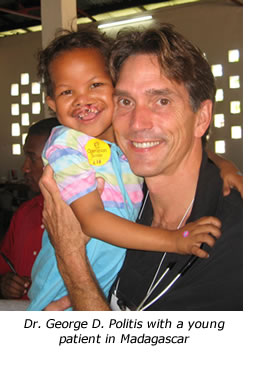 For me, the desire to make a real impact on health care in low-income countries goes back to my earliest days of medical school. It shaped my career choices. The SPA Committee on International Education and Service carries the acronym SPACIES, which might lead you to believe that it is a branch of NASA or possibly a group of holdouts from the 1960’s. SPACIES is in fact neither of those, but rather a like-minded group of pediatric anesthetists who are passionate about and committed to the improvement of pediatric anesthesia delivery in underserved countries.
For me, the desire to make a real impact on health care in low-income countries goes back to my earliest days of medical school. It shaped my career choices. The SPA Committee on International Education and Service carries the acronym SPACIES, which might lead you to believe that it is a branch of NASA or possibly a group of holdouts from the 1960’s. SPACIES is in fact neither of those, but rather a like-minded group of pediatric anesthetists who are passionate about and committed to the improvement of pediatric anesthesia delivery in underserved countries.
Service on short-term surgical projects in low-middle income countries (LMIC), typically called “missions,” is an experience common to our membership. The wish to improve perioperative care during missions has fostered several committee projects. A manuscript published in Anesthesia & Analgesia in 2002 titled “Pediatric Anesthesia for Voluntary Services Abroad,” produced by SPACIES, serves as a valuable resource for anyone providing patient care in this unique setting.
Starting in 2008, SPACIES was actively involved in production of guidelines for high quality perioperative care during plastic surgical missions, working together with Volunteers in Plastic Surgery (VIPS), a committee associated with the American Society of Plastic Surgeons. That effort culminated in guidelines that reside at the VIPS website, and eventually in a more inclusive set of guidelines published in Anesthesia & Analgesia in 2011. Our cooperation with VIPS is ongoing.
In a further effort to improve perioperative care for short-term surgical projects, SPACIES has engaged Wake Up Safe (WUS) to allow Non-Governmental Organization (NGO) participation, and has both Operation Smile and Resurge ready to launch this important quality improvement cooperative. We hope to increase NGO enrollment in WUS, and I encourage organizations to contact me (georgepolitis@virginia.edu) if interested in joining.
Finally, a searchable index, created and updated by Quentin Fisher, MD, resides on the SPA website and serves as a tool for practitioners wishing to locate NGOs that provide medical services in LMICs. The index can be searched according to medical specialty, religious affiliation, mission duration, and more.
Educational efforts have been the cornerstone of SPACIES. Even service related endeavors noted above largely contain educational emphasis. We have lectured, and participated in panels and workshops at SPA meeting, with the goal of improving anesthesia care in LMICs. Missions offer opportunity to collaborate with LMIC colleagues in the OR, and to offer lecture and discussion outside the OR. A lecture series on pediatric anesthesia, produced by SPACIES and residing on the SPA website, was created with the goal of having a repository of high quality lectures ready to give during missions. The SPA Lecture Series, edited by Tae Kim, MD, has evolved into a collection of over 40 peer reviewed, periodically updated, PowerPoint productions, that we envision will serve as a resource for resident and fellow training in LMICs. Our challenge now, is to find ways to make this tool available gratis to training programs in LMICs.
The SPA Committee on International Education and Service has acted as the international branch of the SPA, fielding questions related to international matters. We assisted in program development for the International Assembly for Pediatric Anesthesia (IAPA) and for other SPA meetings, and assisted with the IAPA’s “International Scholar” program. Our committee has promoted SPA support for pediatric anesthesia fellowships run by the World Federation of the Societies of Anaesthesiologists (WFSA), which led to SPA support for the WFSA pediatric anesthesia training program in Vellore, India. We gained similar SPA support for a proposed East African Pediatric Anesthesia Fellowship in Nairobi, and intend to be available to assist with curriculum and with supplying visiting faculty. Finally, SPACIES promotes US based resident participation in clinical anesthesia service abroad, and we believe that we should facilitate availability of this important educational and potentially life-changing opportunity.
The Society for Pediatric Anesthesia’s Committee on International Education and Safety is in its second decade. We plan to refocus our efforts through development of Mission and Vision Statements this fall. We are establishing a web page that will be accessed through the SPA website, and will contain much of the information, the manuscripts, and the tools noted above. Lastly, I want to remind all that participation in our committee needs no invitation. Simply find the SPA Committee Meeting Schedule for Pediatric Anesthesiology 2013 in Las Vegas (or subsequent SPA meetings) and show up. All are welcome.
New Devices for the Management of the Difficult Infant and Pediatric Airways
By Agnes I. Hunyady, MD
Attending Anesthesiologist
Department of Anesthesiology and Pain Medicine
Seattle Children's Hospital
Acting Assistant Professor, University of Washington,
The last decade has seen a rapid proliferation of airway devices on the market, and most manufacturers target the pediatric provider as well. Perhaps the largest array of options can be observed in the field of indirect laryngoscopic devices, but there is a multitude of new supralaryngeal airways as well as tools to make fiberoptic intubation easier. The purpose of this review is to familiarize the reader with a wide variety of options and give some guidance to find the choice that best fits the institution's needs and means. It is the intention of the review to remain free of commercial bias, and the opinions expressed are solely the author's or based on personal communications with pediatric airway experts, but do not reflect the Society's recommendations. The list of devices – partly due to rapidly changing market dynamics - cannot be exhaustive and additional research is recommended before any major investment.
Indirect laryngoscopy is based on the concept that a camera placed close to the tip of the blade will provide an additional angle of view beyond the line of vision obtained with the naked eye from the end of the blade that is proximal to the laryngoscopist. Indirect laryngoscopic devices differ in the angle of view they provide, blade design and size, image quality and magnification and, of course, price.
 Among the video laryngoscopes, GlideScope (Verathon, Bothell, WA, USA) (picture 1.) has the largest market share. Two different non-disposable batons accommodate five different sizes of disposable blades (Stats), making it suitable to manage airways of patients from the smallest to the largest. The large angulation of the blade is both an advantage and a disadvantage. While users usually report a very good view of the glottis even in the most difficult airways, maneuvering the endotracheal tube to the trachea can be challenging and, since a channeled version of the device is not yet commercially available, always requires a relatively sharply bent stylet. The image is of great quality and, due to the built in heating system, devoid of fogging it is displayed on a 6.5 inch camera that can be mounted on a wheeled pole, making the device relatively portable.
Among the video laryngoscopes, GlideScope (Verathon, Bothell, WA, USA) (picture 1.) has the largest market share. Two different non-disposable batons accommodate five different sizes of disposable blades (Stats), making it suitable to manage airways of patients from the smallest to the largest. The large angulation of the blade is both an advantage and a disadvantage. While users usually report a very good view of the glottis even in the most difficult airways, maneuvering the endotracheal tube to the trachea can be challenging and, since a channeled version of the device is not yet commercially available, always requires a relatively sharply bent stylet. The image is of great quality and, due to the built in heating system, devoid of fogging it is displayed on a 6.5 inch camera that can be mounted on a wheeled pole, making the device relatively portable.
 The C-Mac (Karl Storz, Tuttlingen, Germany) (Picture 2a.) is a similarly portable video laryngoscope that, like its less portable but more versatile counterpart from the same company, the V-Mac (Picture 2b.), works with an array of non-disposable metal blades (from Miller 0 to Mac 4) that are the same shape as the conventional blades. Therefore, not only does it enable the user to make an assessment of the Cormack-Lehane grade with direct and indirect laryngoscopy at the same time, but it is also uniquely suitable for teaching. The image is usually of excellent quality, although fogging can be a problem. Storz is the only company that seems to offer a unified concept of difficult airway management. The compact, built-in-one CPU, light source and monitor (Telepack, Karl Storz) of the V-Mac can be used with fiberoscopes and the Bonfil and Brambrink optical stylets (Storz) as well.
The C-Mac (Karl Storz, Tuttlingen, Germany) (Picture 2a.) is a similarly portable video laryngoscope that, like its less portable but more versatile counterpart from the same company, the V-Mac (Picture 2b.), works with an array of non-disposable metal blades (from Miller 0 to Mac 4) that are the same shape as the conventional blades. Therefore, not only does it enable the user to make an assessment of the Cormack-Lehane grade with direct and indirect laryngoscopy at the same time, but it is also uniquely suitable for teaching. The image is usually of excellent quality, although fogging can be a problem. Storz is the only company that seems to offer a unified concept of difficult airway management. The compact, built-in-one CPU, light source and monitor (Telepack, Karl Storz) of the V-Mac can be used with fiberoscopes and the Bonfil and Brambrink optical stylets (Storz) as well.
The Truview PCD (Truphatec, Netanya, Israel) (Picture 3.) has some unique features that make it a favorite in certain “grab and run” situations. Its uniquely angled non-disposable metal blade comes in sizes from neonatal to adult, can be attached to a regular laryngoscope handle in dire situations, and is one of the slimmest and slickest among all options. This makes it a good choice for patients with limited mouth opening. The attached eye piece is handy when there is no time or opportunity to snap on the magnetic camera head that ends in a small but good quality image screen. Perhaps the biggest advantage of the device is that it comes with a side port for oxygen insufflation, which significantly increases the time available for laryngoscopy. Furthermore, it has the added benefit of secretion control. The company's newest product is the Truflex re-useable stylet, in two sizes: adult and pediatric, with a flexible tip that can be bent upwards with a handle on the proximal end without having to remove it from the mouth.
The Pentax AWS (Tokyo, Japan) (Picture 4.) pediatric and neonatal video laryngoscope is similar to the GlideScope in certain features (disposable blades on reusable baton, large blade angulation). Unlike the GlideScope, however, its blades are channeled, eliminating the need for a stylet. With its multi-positional monitor attached to the handle, the device holds the promise of great portability, but results in a lack of internal data storage capability (which can be overcome by external storage via its video-output).
Though not a true video laryngoscope, another look-around-the corner device, the Airtraq (Prodol Meditec, Vizcaya, Spain) (Picture 5.) is a channeled disposable optical laryngoscope that has the advantage of simplicity, affordability and extreme portability. Looking through the eyepiece is a bit awkward, but with the wireless camera attached to the eyepiece, the view can be shared on a 11.5 cm monitor. Although the picture quality is not nearly as good as a video laryngoscope, this fact rarely hinders intubation. The relatively thick blade might limit the device's usefulness in infants with small mouth opening or narrow airways.
Holm-Knudsen recently reviewed the literature on the use of four of these devices in children younger than 2 years of age1. There are not enough data to give evidence-based advice on the best choice for purchase. One clearly does not need to, and should not own all of these devices to feel well prepared. The choice will depend on how often and for what purpose they will be used. For the providers who only occasionally handle difficult pediatric airways, the affordable Pentax (around $6,500 for the non-disposable part and <$20 for the disposable), or Airtraq (around $80/piece) could be the most fiscally responsible choice, but the greater than $20,000 investment in a GlideScope, C-Mac or V-Mac might be a wiser option where a daily use is anticipated, and where clinical, educational or research activities call for acquisition, storage and application of large amount of good quality digital data2.
While video laryngoscopes are gaining popularity due to their sturdiness, ease of use and promise for new and creative applications, flexible bronchoscopic intubation techniques remain the best alternatives in certain situations, and many new products are now available to make the technique easy to apply in infants as well.
Chip-on-tip intubating scopes (video bronchoscopes) provide amazing image quality and magnification, and are now available if not in sizes for infants, but for young children (LF-V, Olympus:4.1 mm). Endoscopy Masks from VBM Medical Inc. (Noblesville, IN) (Picture 6.) are available in four sizes to provide a way for uninterrupted ventilation during flexible bronchoscopic intubation, while Bronchoscope Airways from the same company can keep an open airway while providing conduit for the scope and the endotracheal tube to the pharynx during oral intubation. Parker-tip endotracheal tubes (Parker Medical) – straight or preformed, cuffed or uncuffed – can be used to facilitate tube placement over the bronchoscope. Should the need arise to change the endotracheal tube that secures a difficult infant airway, Cook Exchange Catheters (Cook Medical) are available down to 5 Fr, which fits the lumen of a 3.0 endotracheal tube.
Almost every supraglottic airway device used on adults is now being manufactured in pediatric sizes as well. The device that holds the most promise in the management of the difficult pediatric airway, especially for the use in the cannot-intubate-cannot-ventilate situation, is the AirQ (Cookgas LLC)3 (Picture 7.). The lack of grills allows for easy flexible bronchoscopic intubation through the AirQ as a conduit, the short curved shaft facilitates removal of the AirQ over the endotracheal tube and the wide shaft and removable adapter makes it possible to use a cuffed ETT by allowing easy passage of the pilot balloon.
Cote and Hartnick recently reviewed commercially available devices for creation of a surgical airway in infants and children4. They emphasized that the majority of these devices would only be appropriate for larger children or teenagers, and their placement would require several steps rendering them unsuitable for emergency situations. They advocated the use of intravenous catheter-like devices, especially for infants. One such device is the curved, kink-resistant Ravussin-type catheter, the Ventilation-Catheter (VBM, Medizintechnik GmBH, Sula and Neckar, Germany) (Picture 8.) that is available in three sizes (18 Ga for infants, 14 Ga for children and 13Ga for adults) and has two axially placed connectors: a Luer-lock for jet ventilation and a 15 mm adapter for standard ventilation. If jet ventilation is to be attempted through it, it can be used with a commercially available low pressure jet ventilator – Enk Oxygen Flow Modulator (Cook Medical, Bloomington, IN). One should note that these devices have not been evaluated on infants and young children, and transtracheal cannula placement by anesthesiologists in animals about the size of an infant was found to have a very low success rate5. Similarly discouraging report from the NAP4 database on needle cricothyrotomies in adults suggest that the use of this devices require extreme caution and previous practice on manikins and animal models6.
In summary, the long awaited recent increase in the number and quality of available airway devices for children and infants is exciting not only because it helps close the gap we had between adult and pediatric airway management options, but it also offers many new opportunities for educators and researchers. It is going to be our job to continue to evaluate these tools in clinical situations and collect data to help decide on the right device and the right application for each setting and each situation.
References:
- Rolf Holm-Knudsen.The difficult pediatric airway – a review of new devices for indirect laryngoscopy in children younger than two years of age. Paediatr Anaesth. 2011 Feb;21(2):98-103.
- Bolash R, Hrdlicka V, Kim J, Lesser J, Resta-Flarer F. Managing the Difficult Airway in Children with Congenital Vascular and Lymphatic Malformations of the Head and Neck: A Case Series of 200 Video Laryngoscopies Using the Pediatric GlideScope. Abstract, ASA Annual meeting October 2011., Chicago IL
- Roth AG, Jagannathan N, Pak TY, Amin S, Suresh S. The new air-Q intubating laryngeal airway for tracheal intubation in children with anticipated difficult airway: a case series. Paediatr Anaesth. 2009 Jun;19(6):618-22.
- Cote CJ, Hartnick CJ. Pediatric transtracheal and cricothyrotomy airway devices for emergency use: which are appropriate for infants and children? Paediatr Anaesth 2009; 19 (Suppl. 1): 66-76.
- Johansen K, Holm-Knudsen RJ, Charabi B, Kristensen MS, Rasmussen LS. Cannot-ventilate – cannot intubate an infant: surgical tracheotomy or transtracheal cannula? Paediatr Anaesth 2010; 20:987-993.=
- http://www.rcoa.ac.uk/docs/NAP4_Section2.pdf; last accessed 11/13/11
Peds Passport
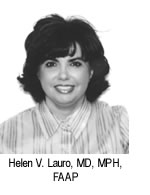 By Helen V. Lauro, MD, MPH, FAAP
By Helen V. Lauro, MD, MPH, FAAP
NOTE: Purchase of travel insurance with air evacuation coverage is highly recommended to meeting attendees and their families.
2013
February 9-10: Vadodara, India
5th National Conference of Indian Association of Paediatric Anaesthesia
Tel: 91 265 2312680
Information: Dr. Falguni Naregal, Organizing Secretary, Neel Surgical Hospital for Children, Karamdham Complex Near Akota Atithi Gruh, Akota, Vadodara-390020, Guujarat, India
Website: www.iapacon2013.org
Email: paedsanaesthesia2013@gmail.comFebruary 17-22: Capetown, South Africa
6th World Congress of Paediatric Cardiology & Cardiac Surgery
Tel: +27 21 532 6333, Fax: +27 21 532 6331
Information: PCCS Conference Secretariat, Global Conferences, P.O. Box 632, Howard Place, Pinelands 7450
Website: www.pccs2013.co.za
Email: info@pccs2013.co.zaMarch 14: Las Vegas, Nevada, USA
Congenital Cardiac Anesthesia Society (CCAS) 2013 Meeting
Tel: 804-282-9780, Fax 804-282-0900
Information: Congenital Cardiac Anesthesia Society, 2209 Dickens Road, Richmond, VA 23230-2005
Website: www.ccasociety.org
Email: ccas@societyhq.comMarch 14-17: Las Vegas, Nevada, USA
Society for Pediatric Anesthesia (SPA)/American Academy of Pediatrics (AAP) Pediatric Anesthesiology 2013
Tel: 804-282-9780, Fax 804-282-0900
Information: Society for Pediatric Anesthesia, 2209 Dickens Road, Richmond, VA 23230-2005
Website: www.pedsanesthesia.org
Email: spa@societyhq.comMay 2-3: Ghent, Belgium
The First European Pediatric Resuscitation & Emergency Medicine Congress
Tel: +31 (0) 887555555; Fax: +31 (0) 887554702
Information: Secretariat ESPA, c/o Department of Anesthesia, Intensive Care and Emergency Medicine, Wilhelmina Children Hospital/University Medical centre Utrecht Lundlaan 6, Mail stop: KG 02.307.1, PoBox 85090, 3508 AB Utrecht, The Netherlands
Website: www.euroespa.org, http://www.prem2013.be
Email: secretary@euroespa.orgMay 17-19: Dallas, Texas, USA
Intensive Review of Pediatric Anesthesia
Tel: 804-282-9780, Fax 804-282-0900
Information: Society for Pediatric Anesthesia, 2209 Dickens Road, Richmond, VA 23230-2005
Website: www.pedsanesthesia.org
Email: spa@societyhq.com
May 20-21: Houston, Texas, USA
2013 Society for Pediatric Sedation Conference: New Frontiers: The Future of Pediatric Sedation
Tel: 804-565-6354, Fax: 804-282-0090
Information: Society for Pediatric Sedation, 2209 Dickens Road, Richmond, VA 23230-2005
Website: www.pedsedation.org
Email: sps@societyhq.comMay 31-June 2: Aurora, Colorado, USA
VII International Symposium on the Pediatric Airway (ISPA)
Tel: (720)-848-6710; Fax: (720)-848-7375
Information: Ms. Beverly Janik, Project Coordinator, Dept. of Anesthesiology, University of Colorado Denver, B113, Leprino Bldg, 7th Floor, 12401 East 17th Avenue, Aurora, CO 80045
Website: www.pedsairwaysymposium.org
Email: Beverly.janik@ucdenver.eduJune 12-15: Rotterdam, Netherlands
24th Annual Meeting of the European Society of Paediatric and Neonatal Intensive Care (ESPNIC)
Tel: +41 22 9080488, Fax: +41 22 9069140
Information: Kenes Group, Rue de Chantepoulet 1-3, P.O. Box 1726, CH-1211 Geneva 1 Switzerland
Website: www.kenes.com
E-mail: info@kenes.comJune 17-20: Stockholm, Sweden
Ninth International Symposium on Pediatric Pain 2013
Tel: +46 8 5465 1500
Information: Congress Secretariat, MCI Stockholm Office, P. O. Box 6911, SE-102 39 Stockholm
Website: www.ispp2013.org, http://www.mci-group.com/sweden
Email: confirmation-sweden@mci-group.com
June 20-21: Cambridge, United Kingdom
Association of Paediatric Anaesthetists of Great Britain and Ireland (APAGBI) Joint Meeting with European Society for Paediatric Anesthesiology (ESPA)
Tel: +44 (0) 20 7631 8887, Fax: +44 (0) 20 76314352
Information: APA Administration Office, AAGBI, 21 Portland Place, London, W1B 1YP, United Kingdom
Website: www.apagbi.org.uk
Email: apagviadministration@aagbi.orgAugust 22-25: Niagara Falls, Ontario, Canada
Anesthesia Update: Emphasis on Pediatrics
Tel: 800-222-6927
Information: Northwest American Seminars, P.O. Box 2797, Pasco, WA 99302
Website: www.nwas.com
Email: info@nwas.comAugust 23-25: Rosemont, Illinois, USA
Intensive Review of Pediatric Anesthesia
Tel: 804-282-9780, Fax 804-282-0900
Information: Society for Pediatric Anesthesia, 2209 Dickens Road, Richmond, VA 23230-2005
Website: www.pedsanesthesia.org
Email: spa@societyhq.comSeptember 5-7: Geneva, Switzerland
Annual Congress of the European Society for Paediatric Anaesthesiology: Geneva 2013
Tel: +31 (0) 887555555; Fax: +31 (0) 887554702
Information: Secretariat ESPA, c/o Department of Anesthesia, Intensive Care and Emergency Medicine, Wilhelmina Children Hospital/University Medical centre Utrecht Lundlaan 6, Mail stop: KG 02.307.1, PoBox 85090, 3508 AB Utrecht, The Netherlands
Website: www.euroespa.org
Email: secretary@euroespa.orgOctober 11: San Francisco, California, USA
Society for Pediatric Anesthesia (SPA) 27th Annual Meeting
Tel: 804-282-9780, Fax 804-282-0900
Information: Society of Pediatric Anesthesia, 2209 Dickens Road, Richmond, VA 23230-2005
Website: www.pedsanesthesia.org
Email: spa@societyhq.comOctober 17-20: Manly, New South Wales (NSW), Australia
Society for Paediatric Anaesthesia in New Zealand and Australia (SPANZA) Conference 2013
Tel: +61 2 4973 6573; Fax: +61 2 4973 6609
Information: SPANZA Secretariat, P.O. Box 180, Morriset, New South Wales, Australia 2264
Email: spanza@willorganise.com.au
Website: www.spanza.org.au/index.php/news-events/events
2014
March 6: Fort Lauderdale, Florida, USA
Congenital Cardiac Anesthesia Society (CCAS) 2014 Meeting
Tel: 804-282-9780, Fax 804-282-0900
Information: Congenital Cardiac Anesthesia Society, 2209 Dickens Road, Richmond, VA 23230-2005
Website: www.ccasociety.org
Email: ccas@societyhq.comMarch 6-9: Fort Lauderdale, Florida, USA
Society for Pediatric Anesthesia (SPA)/American Academy of Pediatrics (AAP) Pediatric Anesthesiology 2013
Tel: 804-282-9780, Fax 804-282-0900
Information: Society of Pediatric Anesthesia, 2209 Dickens Road, Richmond, VA 23230-2005
Website: www.pedsanesthesia.org
Email: spa@societyhq.comMay 15-16: Leeds, United Kingdom
Association of Paediatric Anaesthetists of Great Britain and Ireland Meeting
Tel: +44 (0) 20 7631 8887, Fax: +44 (0) 20 76314352
Information: APA Administration Office, AAGBI, 21 Portland Place, London, W1B 1YP, United Kingdom
Website: www.apagbi.org.uk
Email: apagviadministration@aagbi.org
Footnote:
Please forward all information concerning congresses relevant to
Pediatric Anesthesia to:
Helen V. Lauro, MD, MPH, MSEd, FAAP, SUNY Downstate Medical Center University Hospital of Brooklyn at Long Island College Hospital, Department of Anesthesiology, 339 Hicks Street, Brooklyn, New York 11201.
